Alexander
http://www.livius.org/aj-al/alexander/alexander00.html
http://classics.mit.edu/Plutarch/alexandr.html
http://www.touregypt.net/featurestories/alexanderthegreat.htm
http://en.wikipedia.org/wiki/Alexander_the_Great
Alexandria
http://alexandriatour.com/
http://en.wikipedia.org/wiki/Alexandria
http://www.bibalex.org/English/index.aspx
Ptolemies
http://www.houseofptolemy.org/
http://en.wikipedia.org/wiki/Ptolemaic_dynasty
http://www.livius.org/ps-pz/ptolemies/ptolemies.htm
Roman Egypt
http://www.livius.org/caa-can/caesar/caesar_t13.html
http://www.houseofptolemy.org/#GRECO
http://www.romeinegypt.unipi.it/index.php?pageId=7
http://en.wikipedia.org/wiki/%C3%86gyptus
Click on images or links for larger versions of the images.
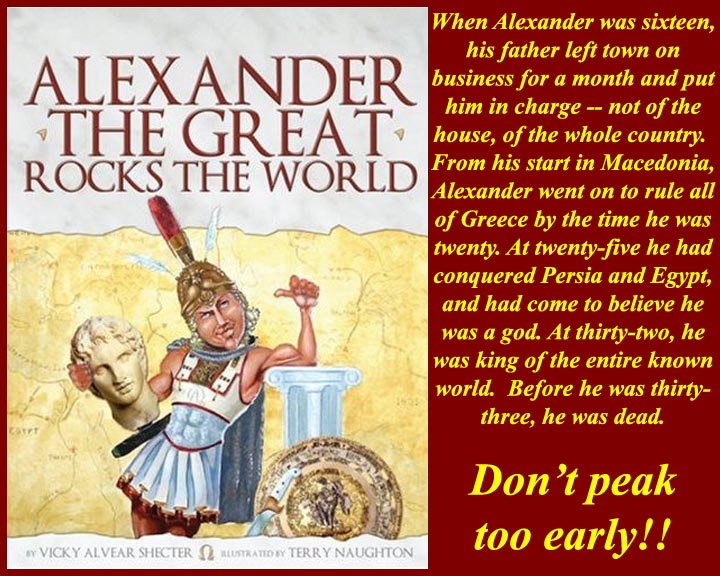
http://www.mmdtkw.org/EGtkw0901AlexanderRocks.jpg
Alexander apparently had better organizational skill than his opponents, and therefore beat the tar out of them. One of the characteristics that set him apart from leaders of other countries was decisiveness, and he followed that with speed of action. His staff and soldiers put up with his demands because early on they realized that they produced quick victories and plenty of loot. He died young, at a little less than 33 in 323 BC, but he actually surpassed the average terminal age of his time and place, which was about 30 -- infection took out just about everyone.
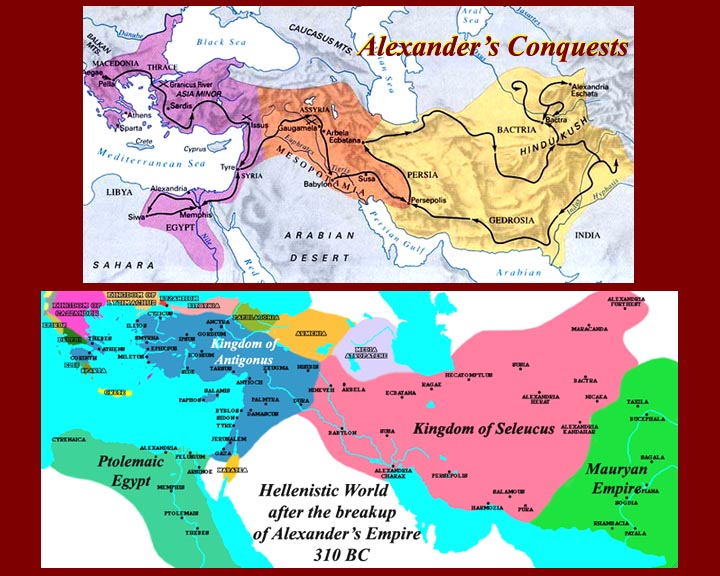
http://www.mmdtkw.org/EGtkw0902HellenisticWorld.jpg
Alex didn't conquer the known world as we often hear, but he did get pretty much of what was "civilized". Civilized can be literally translated as "citified", and cities were "where the money was". (Bank robber Willie Sutton, by the way, always maintained that he never said that about why he robbed banks.) Alexander always had to conquer the next town to pay off his army. The route map of his conquests is apparently accurate, and he left towns named after himself all along the way. When he died (323 BC), his generals fought amongst themselves for decades. But the borders of their domains were mostly settled by 310 BC. Three major Hellenistic kingdoms had emerged, and they maintained a precarious balance of power until the Roman conquests of the second and first centuries BC: Egypt, ruled by Ptolemy and his successors; Asia, comprising most of the remaining provinces of the Persian empire and held together with great difficulty by the dynasty founded by Seleucus; and Macedonia and Greece, ruled by the descendants of Antigonus the One-Eyed. The Antigonids in Macedonia followed the model of Alexander's father Philip in posing as national kings chosen by the army, the Ptolemies ruled Egypt as divine pharaohs, and some of the Seleucids became deified "saviors" and "benefactors." Ptolemaic and Seleucid administrations were centralized in bureaucracies staffed by Greeks, an arrangement that created a vast gulf between rulers and ruled.
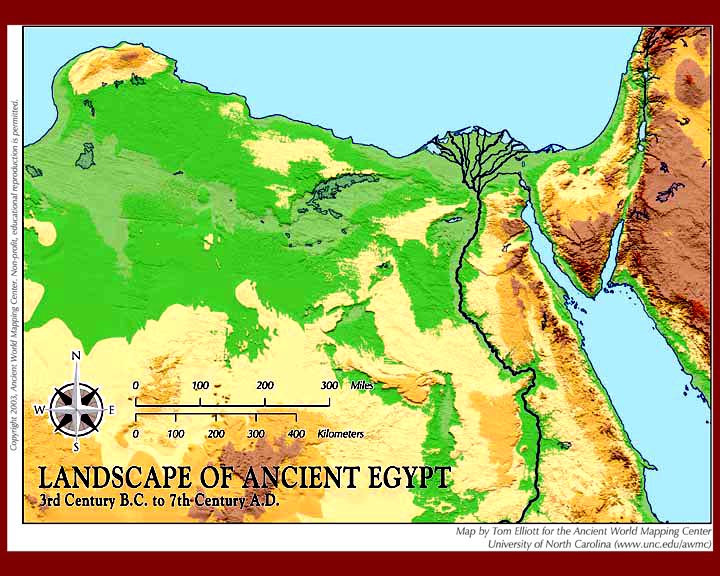
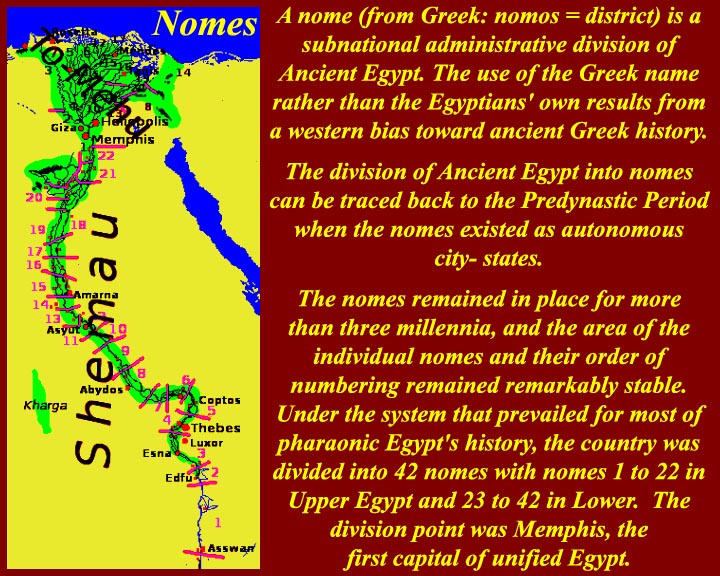
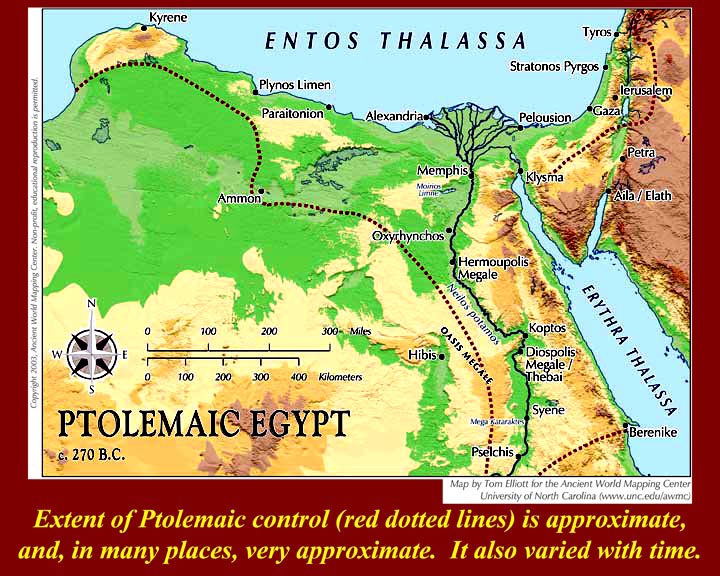
http://www.mmdtkw.org/EGtkw0903EgyptMapLand.jpg
http://www.mmdtkw.org/EGtkw0904aNomesEgypt.jpg
http://www.mmdtkw.org/EGtkw0904EgyptMapPtolemaic.jpg
When Alexander arrived, he was received as a liberator of Egypt: nobody liked the oppressive rule of the Persians who had taken control of Egypt for the second time shortly before Alexander marched his troops around the eastern end of the Mediterranean.
He "inherited" the Egyptian physical and political landscape and soon had himself declared Pharaoh and added a Macedonian Greek administrative layer to the top of the pre-existing structure. The main purpose of that structure was to extract taxes and customs duties (in his new port city, Alexandria) to finance his new adventures further to the east. Within a short time, he marched back out leaving his representatives in charge. The Egyptian power structure saw that there was money to be made by everyone, so they didn't resist.
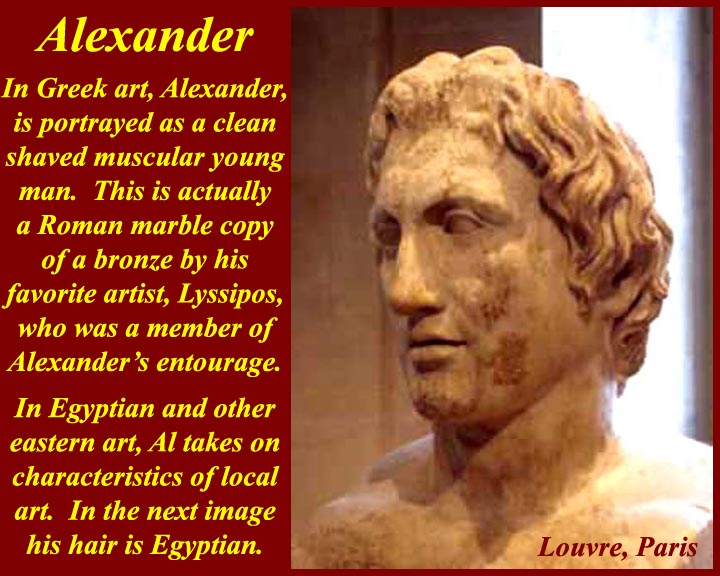
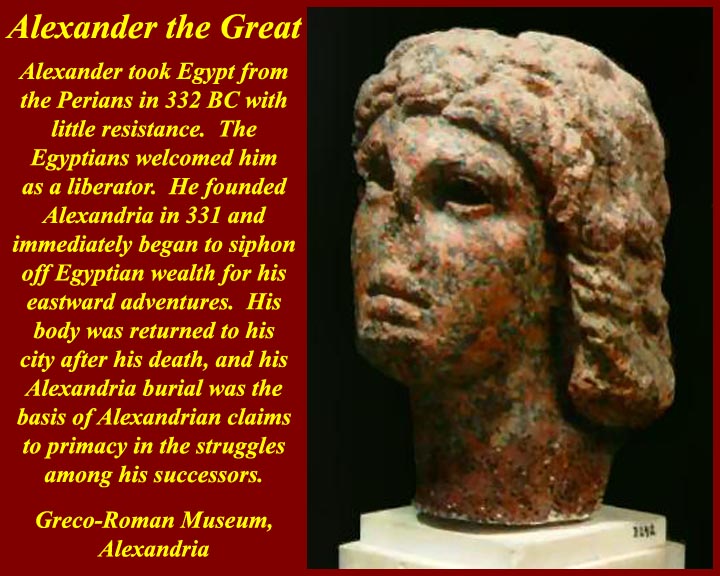
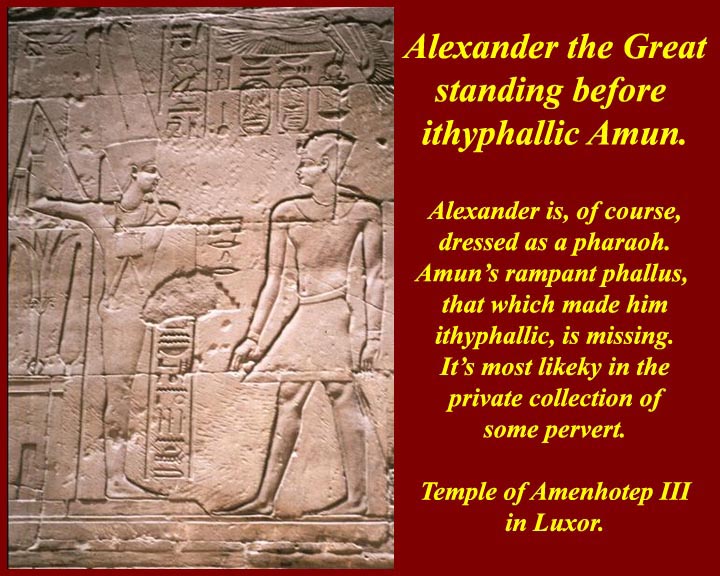
http://www.mmdtkw.org/EGtkw0905AlexandreLouvre.jpg
http://www.mmdtkw.org/EGtkw0906AlexanderEgyptian.jpg
http://www.mmdtkw.org/EGtkw0907AlexanderAmunLuxor.jpg
Like any good politician, Alexander was a chameleon who could take on whatever image pleased the local population.
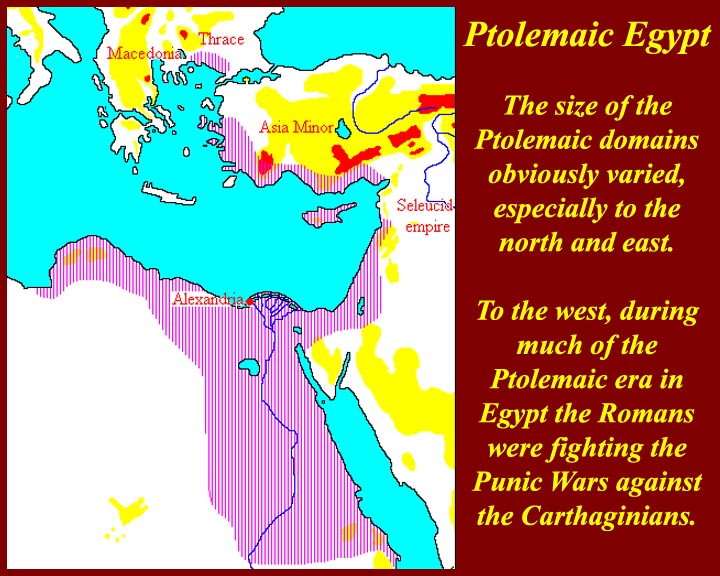
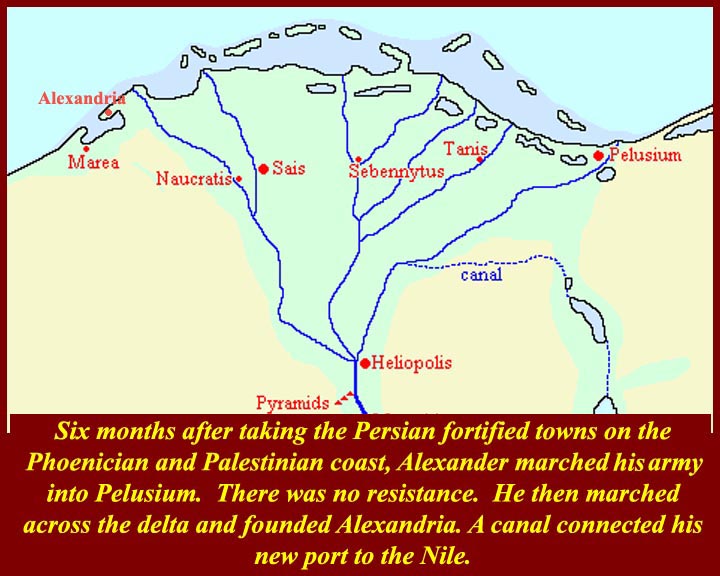
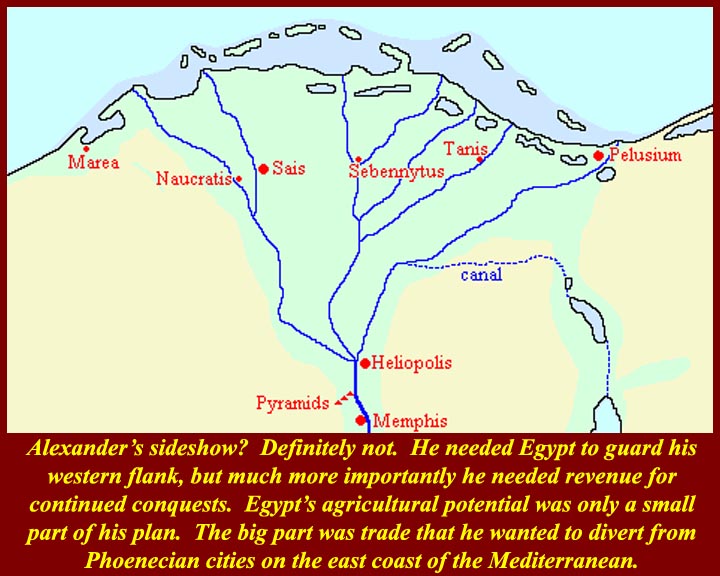
http://www.mmdtkw.org/EGtkw0908PtolemaicEgypt.jpg
http://www.mmdtkw.org/EGtkw0909DeltaMarch.jpg
http://www.mmdtkw.org/EGtkw0910NoSideshow.jpg
The size of Ptolemaic "Egypt" fluctuated somewhat as the power struggle continued for several decades after Alexander's death. At the beginning, however, that is, when Alexander marched eastward, his western Mediterranean conquests were left in charge of the new Macedonian-Egyptian bureaucracy. Alexander's conquest had been swift. He arrived at Pelusium at the eastern edge of the Nile delta in October of 332 after a one week forced march down of 130 miles down the Levantine coast. The city was heavily fortified, but it surrendered immediately without a fight. The people had already ousted the Persians. He then marched right across the delta (again with no resistance), and, in short order, he had founded Alexandria. Egyptian cities down the Nile didn't even need his presence to surrender. It's recorded that he visited Thebes (Luxor), he probably saw the pyramids, may have taken a Nile cruise -- more as a visiting monarch on a progress than as a general leading a conquering army. He was proclaimed pharaoh -- but no coronation is recorded -- and then left and eventually died on the road.
[P.S. -- Why is Egypt in quotation marks above? Because Egypt rightfully became "Egypt" only when the Macedonian, Greek, Ptolemaic bureaucracy named it that. In fact, except when they now speak our language, it's never been "Egypt" to any "Egyptian". I suppose that's OK, because they call us "al-wilayaat al-mutahida", the first word, used in the plural, is derived from a Turkic political unit (like, for example, a "state") and the second means, in Arabic, "made one", i.e., "united".]
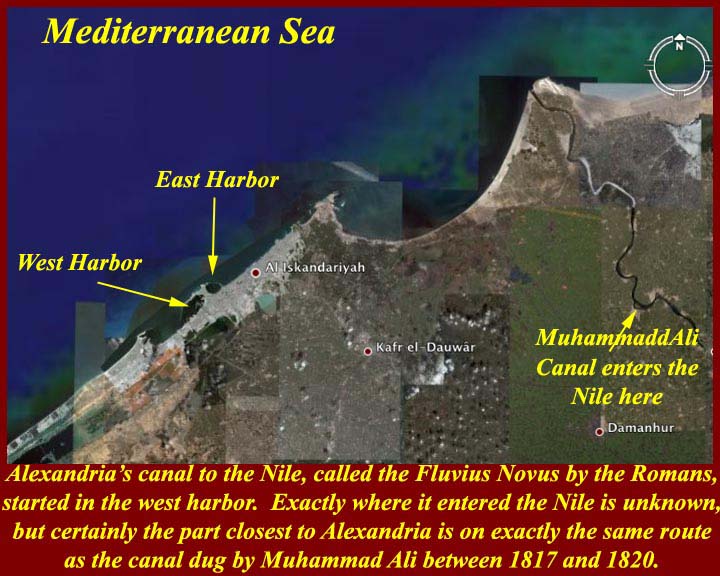
http://www.mmdtkw.org/EGtkw0911AlexandriaCanal.jpg
Alexander's plan was to use Egypt as a forward base for his further conquests and to have Alexandria as his port. He had taken the Phoenician ports from the Persians, who had conquered them a few years earlier, but he wanted a port inside his own lines and firmly under the control of his own customs bureaucracy. (He also wanted to use Egyptian agriculture to supply food to his forces, but he quickly outran his logistics train and his army lived off the newly conquered lands. There had been Egyptian Mediterranean trade for years before the Greeks arrived, but entry into the delta mouths of the Nile was always hazardous due to shifting sand bars. Alexandria had a natural harbor protected by the permanent Pharos Island, but with no connection to the Nile. The Greeks, using Egyptian labor, of course, improved the harbor and dug a canal connecting its commercial side to the Nile.
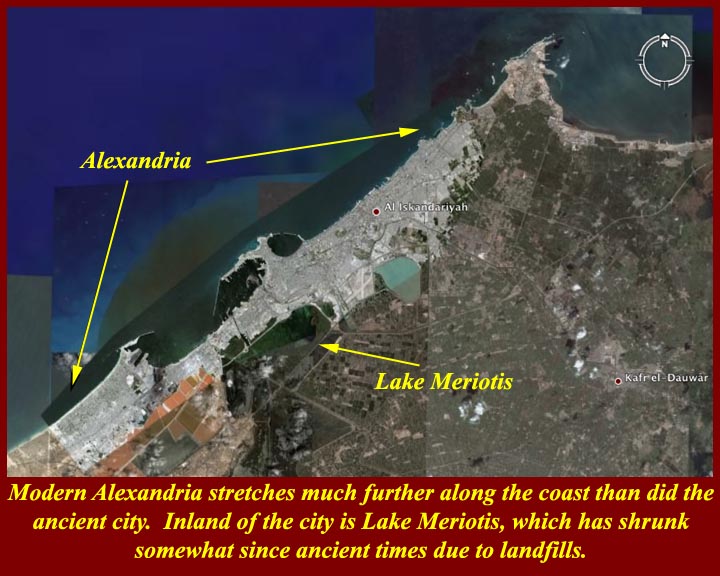
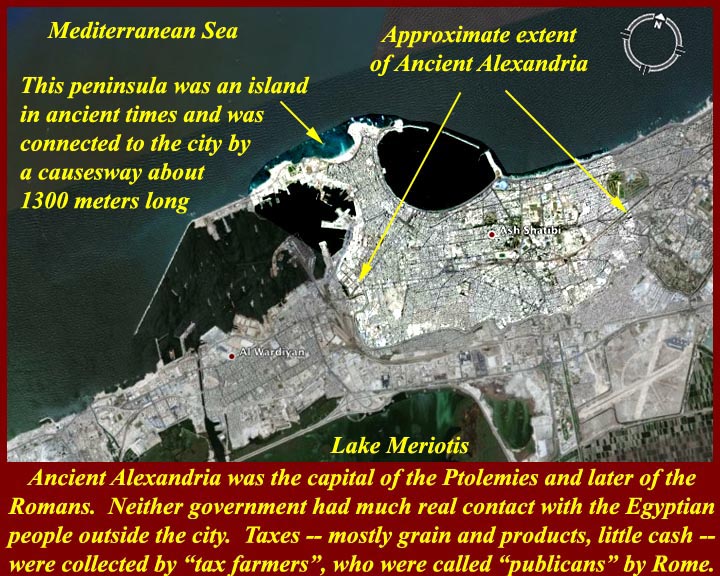
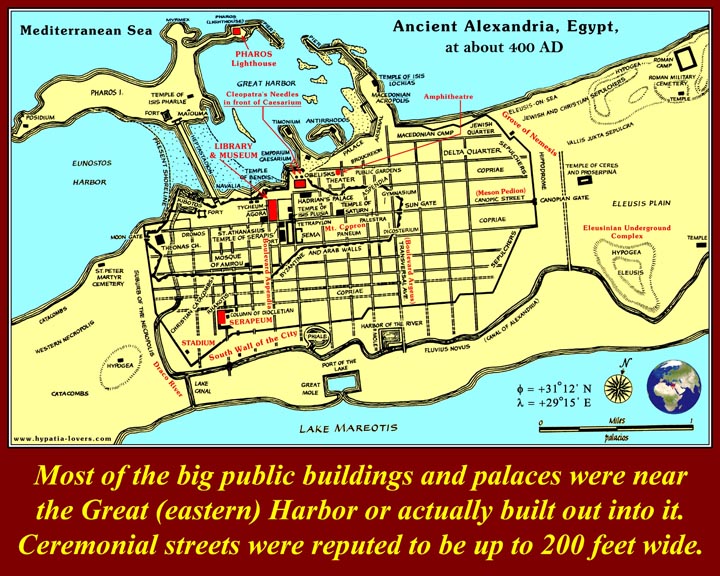
http://www.mmdtkw.org/EGtkw0912ModernAlexandriaCity.jpg
http://www.mmdtkw.org/EGtkw0913AncientAlexSatellite.jpg
http://www.mmdtkw.org/EGtkw0914AncientAlexMap.jpg
Modern Alexandria stretches 20 miles westward along the Mediterranean coast starting at the western side if the Nile delta. Ancient Alexandria was a much smaller fortified town on the coast just behind Pharos Island. The Greeks built a causeway to the Island and thereby separated the Eastern and western halves of the port area. Breakwaters further enclosed what now had become two separate ports, the eastern one becoming the royal government port and the western becoming the commercial port. As can be seen from the satellite images, they are still the same apart from the widening of the "heptastadion" causeway. Lake Meriotis, behind Alexandria has also shrunk due to landfill.
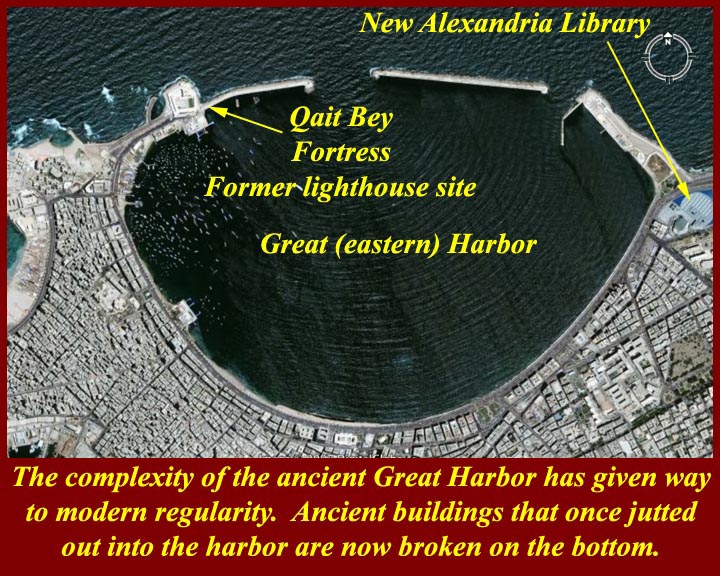
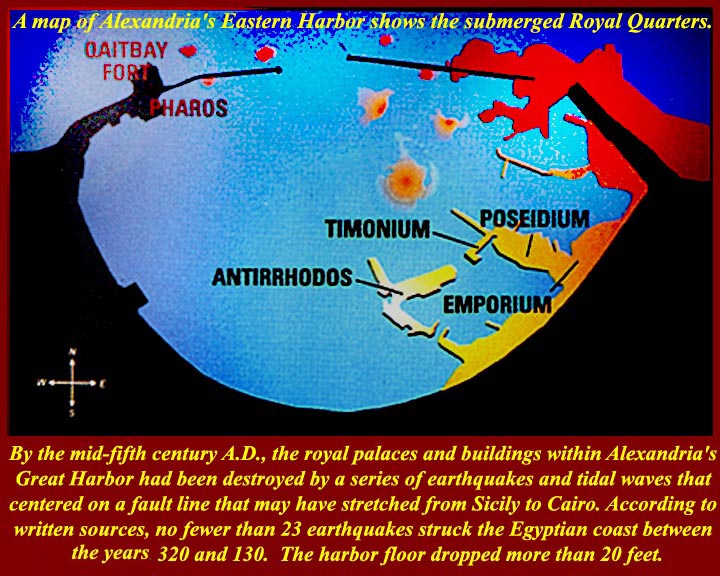
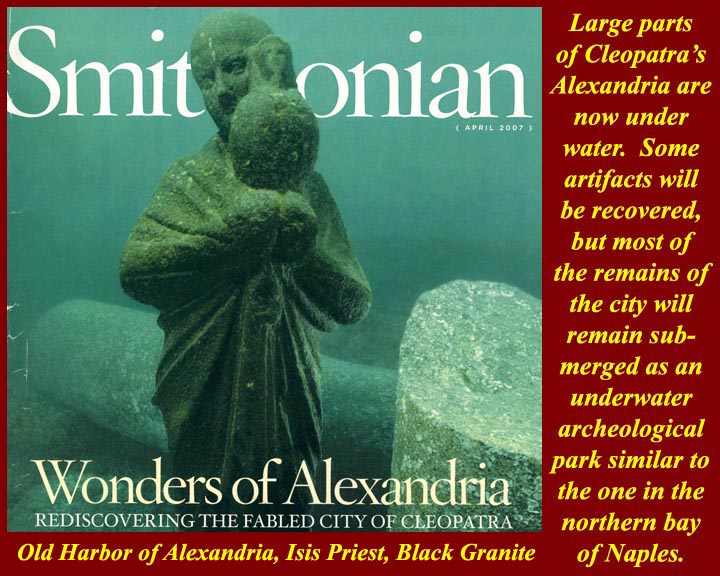
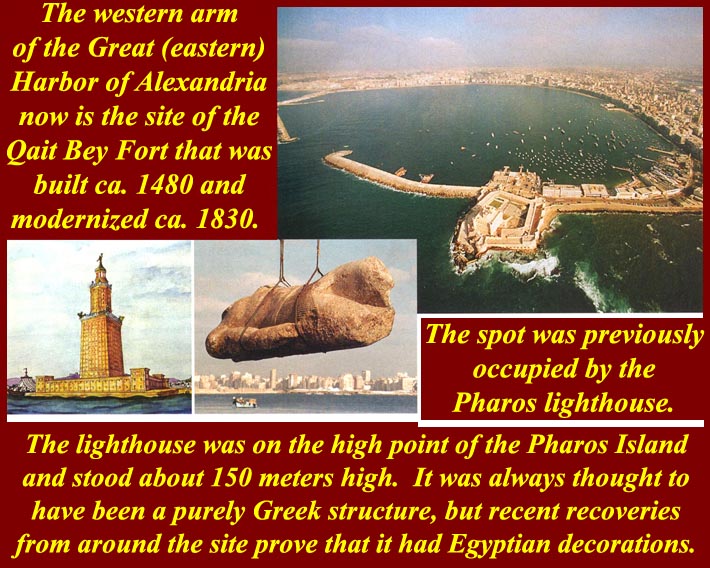
http://www.mmdtkw.org/EGtkw0915ModernEasternHarbor.jpg
http://www.mmdtkw.org/EGtkw0916AlexHarborSubsidence.jpg
http://www.mmdtkw.org/EGtkw0917AlexOldHarbor3.jpg
http://www.mmdtkw.org/EGtkw0918aAlexOldHarbor2.jpg
The modern eastern harbor hides much of the district that housed the palaces and their precincts. Earthquakes over the centuries have dropped the harbor floor more than 20 feet. Recent underwater searches have yielded some finds that are now in the Alexandria and National museums, but there is just too much to raise. The solution is an underwater archeological park -- no diving without a guide.


http://www.mmdtkw.org/EGtkw0918aAlexOldHarbor2.jpg
http://www.mmdtkw.org/EGtkw0918bPharosLighthouseAlexandria.jpg
The lighthouse on the Pharos Island was one of the seven ancient Greek "theamata". That word translates as spectacles or "spectaculars" or "must sees", but we call them the seven "Wonders of the World", a widely-known list of remarkable man made constructions of classical antiquity. It was based on guide-books popular among Hellenic sight-seers and only includes works located around the Mediterranean rim. (Fires and earthquakes have brought down six of the "theamata" leaving only the pyramids. With a height variously estimated at between 115 and 150 meters (383 - 450 ft) the Pharos lighthouse was among the tallest man-made structures on Earth for many centuries. It was the third tallest building after the two Great Pyramids (of Khufu and Khafra) for its entire life. Some scholars estimate a much taller height exceeding 180 meters that would make the tower the tallest building up to the 14th century. It fell in the 1300s during an earthquake, but by that time it had been neglected for many years. The Qait Bey fortress, named after its builder, the Mamluke Qait Bey, who ruled Egypt between 1468 and 1496, now stands where the lighthouse stood. (Other Qait Bey monuments include his funerary mosque in Cairo and an ornate pilgrims' fountain near the Dome of the Rock in Jerusalem.)
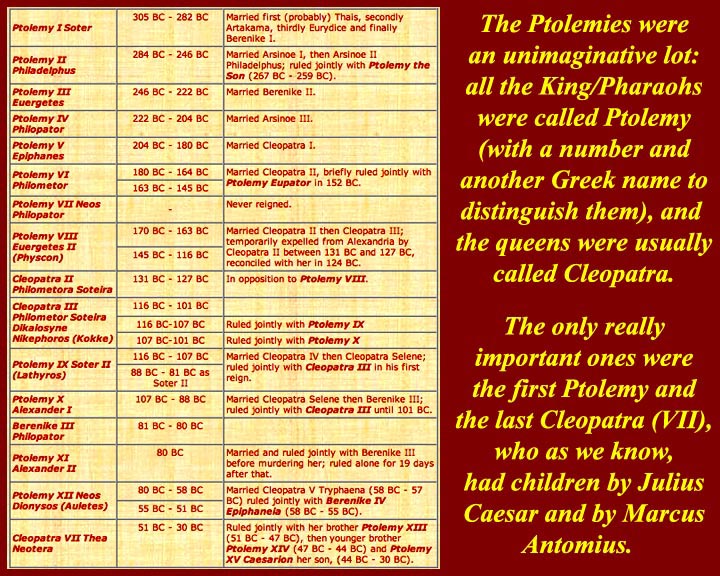
http://www.mmdtkw.org/EGtkw0919PtolemyList.jpg
The Ptolemies are called the Ptolemies because all of the male rulers of the line were called Ptolemy. During their period there were 15 of them from Ptolemy I Soter ( = "the savior" [of Rhodes]) to Ptolemy XV Caesar, AKA Caesarion, the short lived son of Julius Caesar and Cleopatra VII. All the women were called Cleopatra, Berenike, or Arsinoe, and some of them actually ruled, sandwiched in between the various Ptolemies. Some of the women were co-holders of the pharaonic throne, and some succeeded their husband-brothers. The Ptolemies continued the incestuous practices of their Egyptian predecessors. Throughout the Ptolemaic period, the Ptolemies also continued the long standing tradition of palace (harem) intrigues -- every wife and concubine wanted her little Ptolemy to succeed to the throne, and there were always willing priests, courtiers, and bureaucrats to help them. See http://www.houseofptolemy.org/.
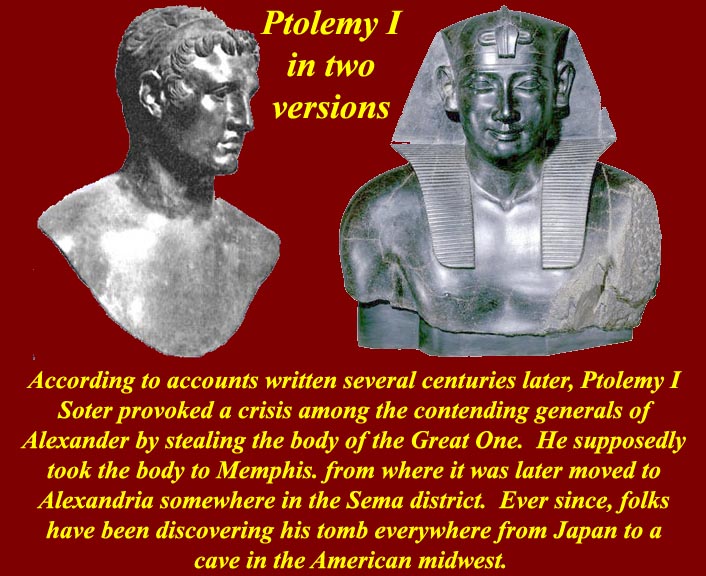
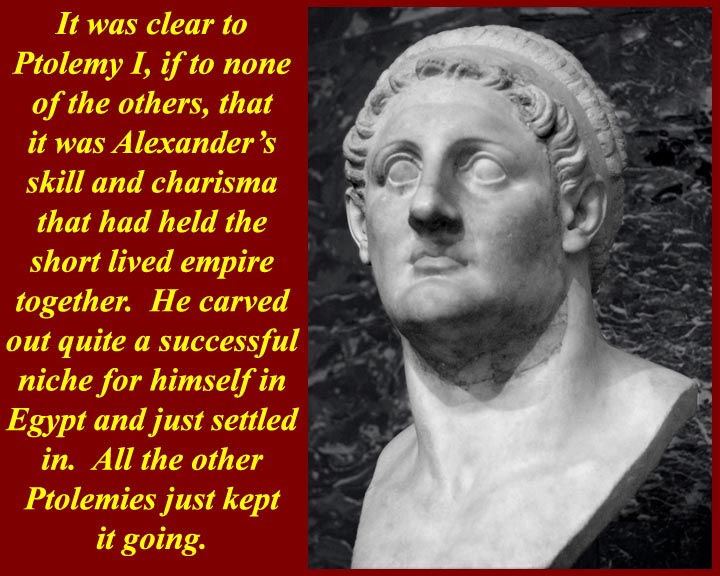
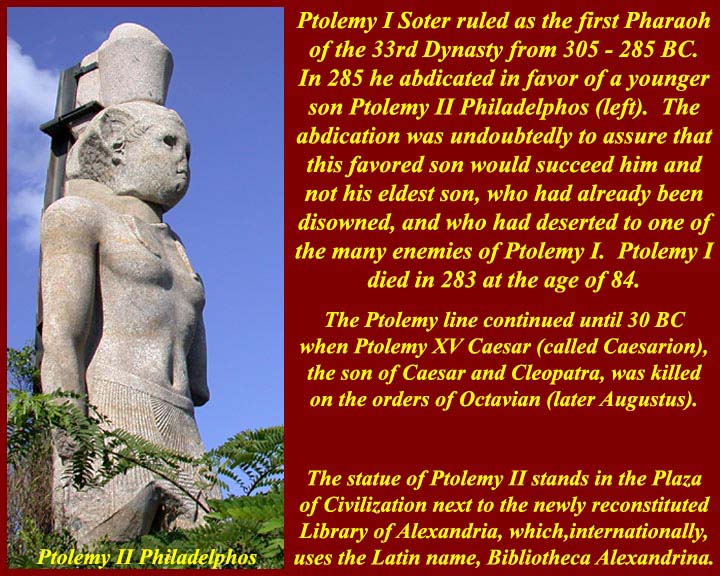
http://www.mmdtkw.org/EGtkw0920PtolemyISoter.jpg
http://www.mmdtkw.org/EGtkw0921aPtolemyISoterLouvre.jpg
http://www.mmdtkw.org/EGtkw0921bPtolemySuccesion.jpg
Ptolemy I Soter had problems. They included attempts by co-heirs to Alexander's conquest to exert primacy and nibble at the edges of his sphere of influence, and they a they also apparently included palace intrigues. After "saving" Rhodes from an Antigonid grab, the people there proclaimed him "Soter" -- more likely the title was issued by his propaganda office.
Diodorus of Sicily says this about the Antigonid siege of Rhodes in his World History:
"The siege started in 305, but
Rhodes was reinforced by Cassander and Lysimachus and
especially Ptolemy. They all knew that as long as Rhodes
withstood Demetrius, they were safe. The siege lasted long
and ended in a compromise. The Rhodians promised that they
would be loyal to Antigonus and Demetrius and would support
them against all their enemies, except Ptolemy. In the
propaganda of Antigonus, this was presented as a big
victory, and Demetrius accepted the surname Poliorcetes,
'taker of cities'. Ptolemy also received an additional name:
he was called Soter, the Savior. Thus ended the siege of
Rhodes."
Inside the palace, Ptolemy I had family problems. His eldest legitimate son, Ptolemy Ceraunus, whose mother, Eurydice, the daughter of Antipater, had been repudiated, fled to the court of Ptolemy's rival, Lysimachus. In 285 BC Ptolemy Soter made his son by Berenice, Ptolemy II Philadelphus, his co-regent. Ptolemy I Soter died in 283 at the age of 84. He left to Ptolemy II Philadelphus a compact and well-ordered realm at the end of forty years of war. By the time he died he was popular with his Greek soldiers and bureaucrats and had done much to win keep the native Egyptian population on his side. He was a ready patron of letters, founding the Great Library of Alexandria. He himself wrote a history of Alexander's campaigns that has not survived. For centuries his history was considered an objective work, distinguished by its straightforward honesty and sobriety. More cynical modern historians believe that Ptolemy may have exaggerated his own role, and had propagandist aims in writing his History. Although now lost, it was a principal source for the surviving account of Alexander's life by Arrian of Nicomedia.
For more on Ptolemy I Soter, see http://en.wikipedia.org/wiki/Ptolemy_I_Soter
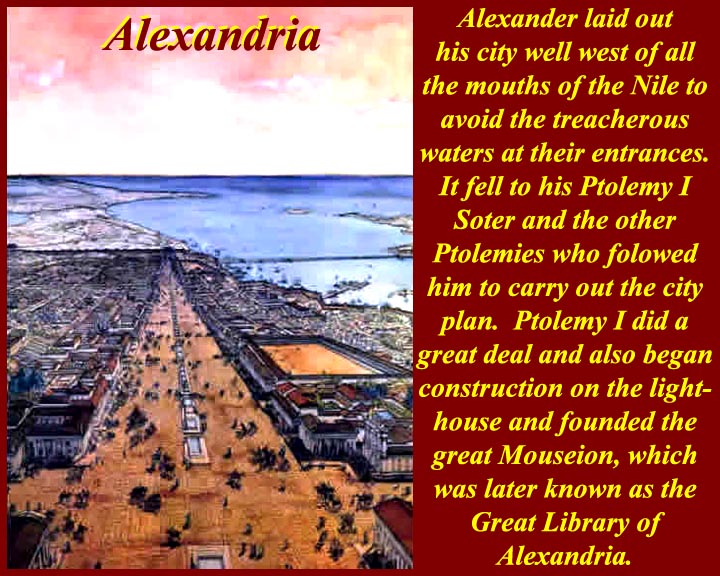
http://www.mmdtkw.org/EGtkw0921cPtolemeicAlexandria.jpg
The Ptolemaic city of Alexandria was a great success, particularly after its North African rival, Carthage, was reduced by the Romans in the Punic Wars. In its later years of independence (i.e., before the Roman conquest) it supplied needed commodities to the Roman armies that were romping around further north in the Middle East. Alexandria's wide avenues, public buildings. and palaces brought the city good publicity, and it became a tourist attraction much as it is now. It was also the only gateway to a more ancient attractions deeper in Egypt. The Museion and Library made Alexandria one of the first international university cities: the Ptolemies easily attracted (stole) "professors" from other Mediterranean seats of learning by offering grants, lodgings, and tax exemptions.
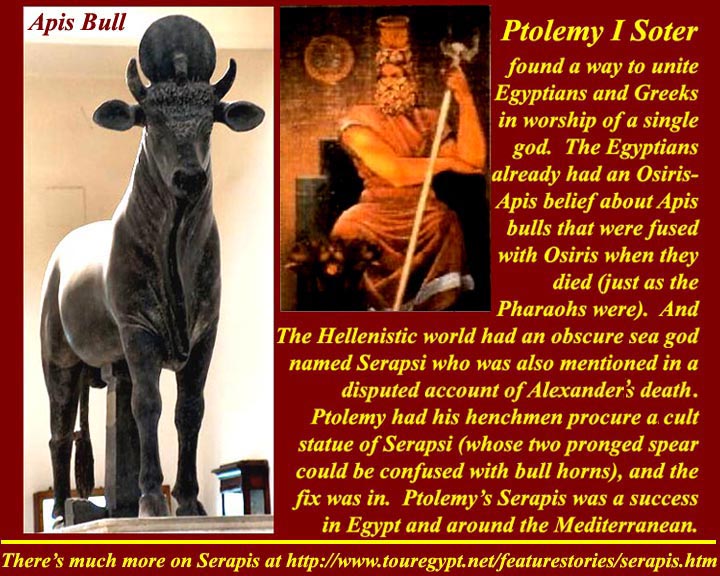
http://www.mmdtkw.org/EGtkw0922Serapis.jpg
How do you solve the problem of competing religious beliefs? What do you do if the bosses (Greeks) and the people (Egyptians) have whole different sets of gods? In Egypt the answer was always the same: invent a new god that combines the attributes of of gods of both groups. We've already seen examples of how that works: gods of neighboring nomes get together and soon a child is born. The new offspring completes the triad and together they head the new local religion. The Ptolemies, of course had the larger problem of working with two complete "national" pantheons. Their solution was "Serapis", and it worked like this. There already was an Egyptian Serapis, itself a fusion the Ser (Osiris in Greek) and Apis mythologies. The Babylonian god Serapsi, a sea god who could easily be confused with the Greek Poseidon or Roman Neptune, was the Greek contribution. The two pronged spear that Serapsi carried looked somewhat like the horns of the Apis bull. Put a solar disk between the two prongs, add a (much disputed) mention of Serapsi in Alexander's death scene and a convenient dream by Ptolemy I and a purloined statue of Serapsi from Sinope and two pliant religious scholars (one Greek and one Egyptian) and an equally pliant an superstitious public and, all together, you have a new Serapis that everyone can like. A huge new Alexandria Serapion with a subsidized priesthood along with revitalization of the Egyptian Ser-Apis cult also with a subsidized priesthood made the picture complete: religious unity. Wait. There's more. In the new religion, Serapis is married to Isis, and, to complete the Ptolemaic triad, they have a son called Harpocrates, which is, in Egyptian, Har-pa-khered or Heru-pa-khered meaning "Har, the Child". Har/Heru, of course, being the Egyptian word for Horus). For more on the subject, see http://en.wikipedia.org/wiki/Serapis and http://en.wikipedia.org/wiki/Harpocrates.
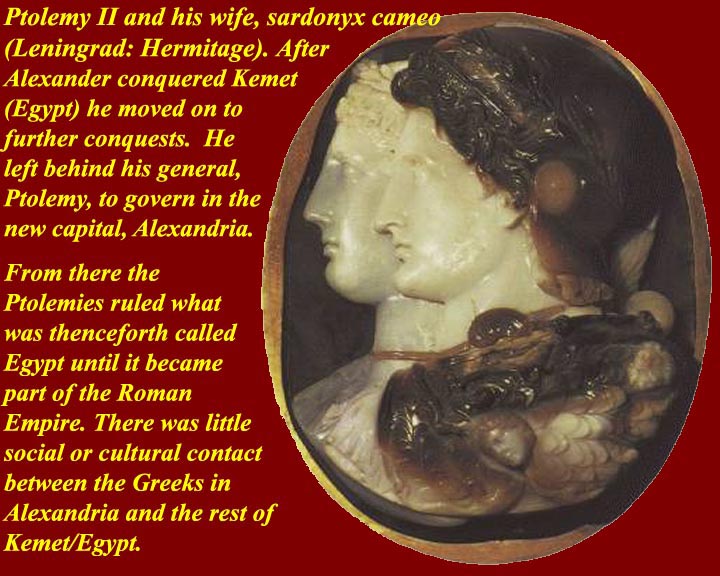
http://www.mmdtkw.org/EGtkw0923CameoPtolemyII.jpg
New Ptolemaic art forms commemorated the Ptolemies. Cameos were popular in Greece as early as the 6th century BC and later in Rome, but they never aroused any popular sentiment in Egypt. There was, in fact, little contact between the Greek superstructure of the Ptolemies and the Egyptian population. The Ptolemies continued their internal intrigues and their external rivalries with other Hellenic successor states, but had little direct impact on the outside world. They had one more brush with "history", and it was disastrous.
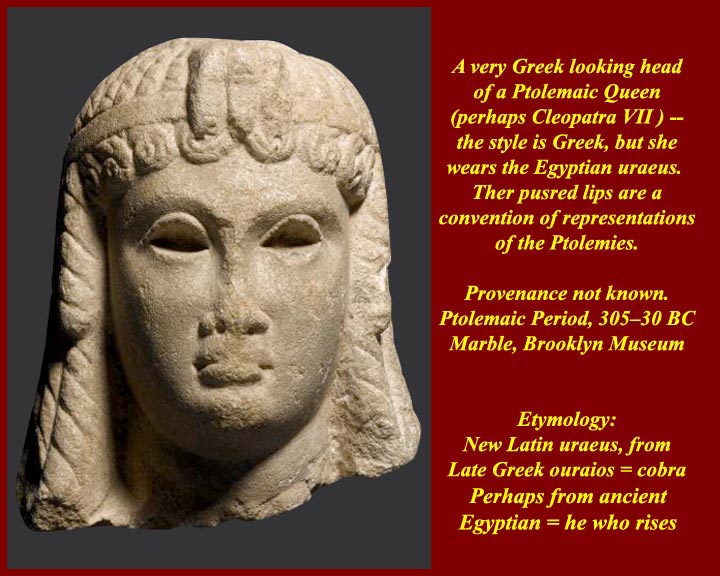
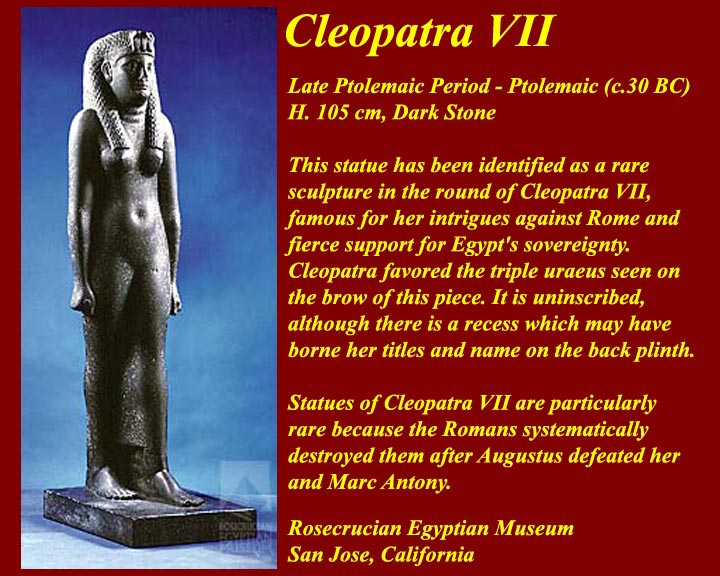
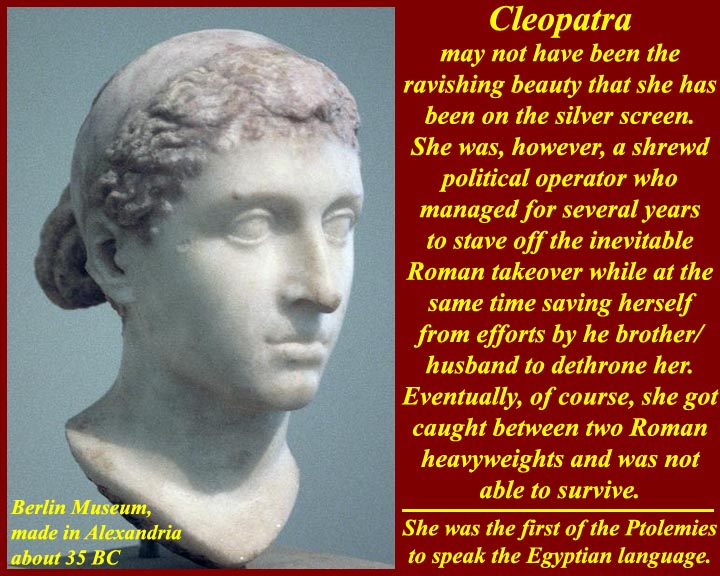
http://www.mmdtkw.org/EGtkw0924CleopatraVII.jpg
http://www.mmdtkw.org/EGtkw0925CleoVii.jpg
http://www.mmdtkw.org/EGtkw0926CleoBust.jpg
Cleopatra VII was at the center of Egypt's last independent fling, but first it's necessary to look at some of a representative sample of what Ptolemaic Egypt produced in art an imagery. Note that Cleo is wearing the Egyptian uraeus and early Greek hairstyle in the first image. She's pure Egyptian (and almost erotic) in the second. In the third, she has a has a later Greek hairstyle, and she is wearing in her hair the Greek ribbon diadem that was introduced by Alexander and became a symbol of kingship throughout the Mediterranean. (Caesar's assassins accused him of getting supporters to hang diadems on his statue in the forum.)
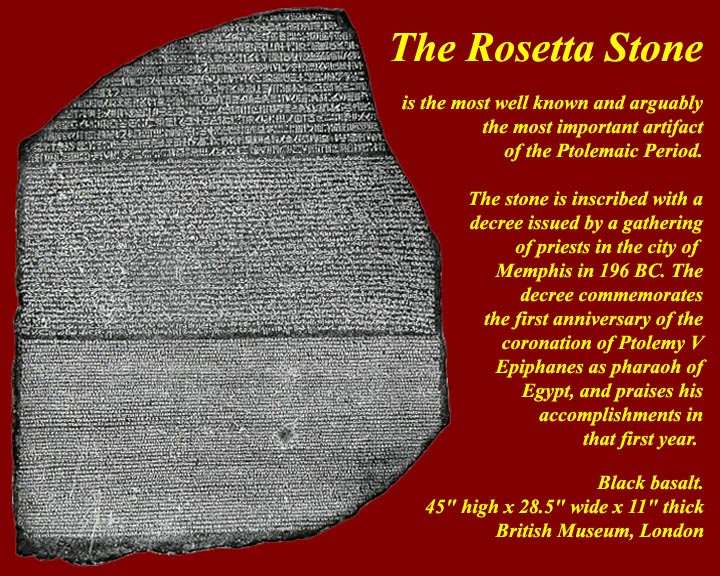
http://www.mmdtkw.org/EGtkw0927RosettasStone.jpg
Perhaps the most important artifact of Ptolemaic Egypt, as far as we are concerned, is this stone found in reuse in Rosetta by Napoleons troops. From the ancient Egyptian viewpoint, it was just another puff piece produced by Memphis priests in 196 BC to commemorate the first anniversary of the beginning of the reign of Ptolemy V Epiphanes.
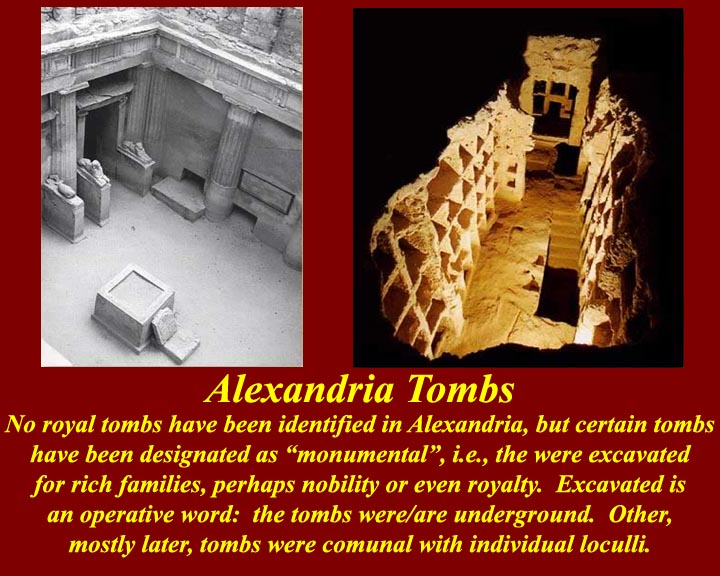

http://www.mmdtkw.org/EGtkw0928AlexandriaTombs.jpg
http://www.mmdtkw.org/EGtkw0929Alexnecropolisess.jpg
In societies that respect their dead, graves and grave goods are left untouched, they are finally dug up and touched by later freebooters called archeologists. But the Egyptians had no real compunctions about plundering the graves of earlier generations -- each individual just wanted his own mummy to last forever. We are left with empty graves, but they can still provide much information. Some of the big Ptolemaic necropolises around Alexandria have been partially excavated. There are, as one would expect, extravagant and simple graves reflecting the spread of the layers of society. Some districts of the necropolises house large Individual and family graves, and some have communal graves where repose individuals with some form of relationship that is not necessarily familial -- burial societies with members sharing common work became common in later years. In all the Ptolemaic necropolises, Greek cremation was practiced almost to the exclusion of mummification. The second image shows a section of a large cemetery "discovered" while a road to the western port was being built. A preservation dig was launched to study the graves and eventually this section was bridged over. But the greatest part of the cemetery is under the apartment buildings and will probably never be scientifically excavated -- it was already excavated once with bulldozers and power shovels during the construction of the apartments. It's unlikely that this is any great loss. The locations of the necropolises have been known for centuries -- ancient maps exist -- and a representative sample has been/will be dug up and studied.
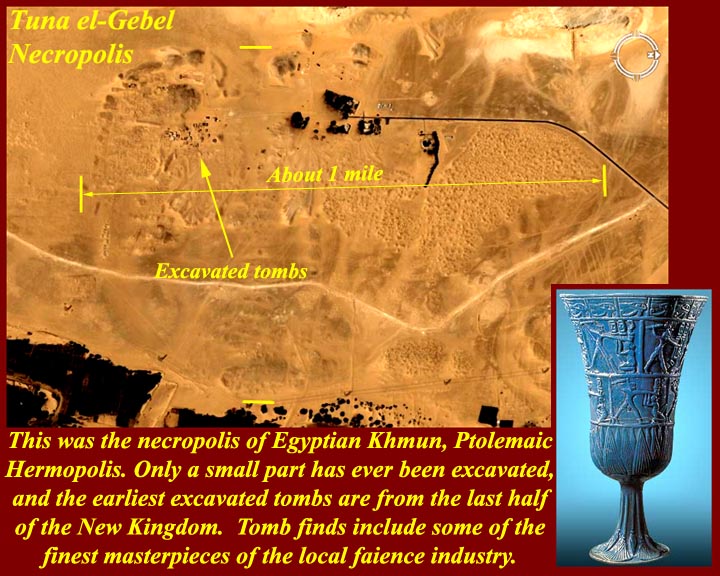
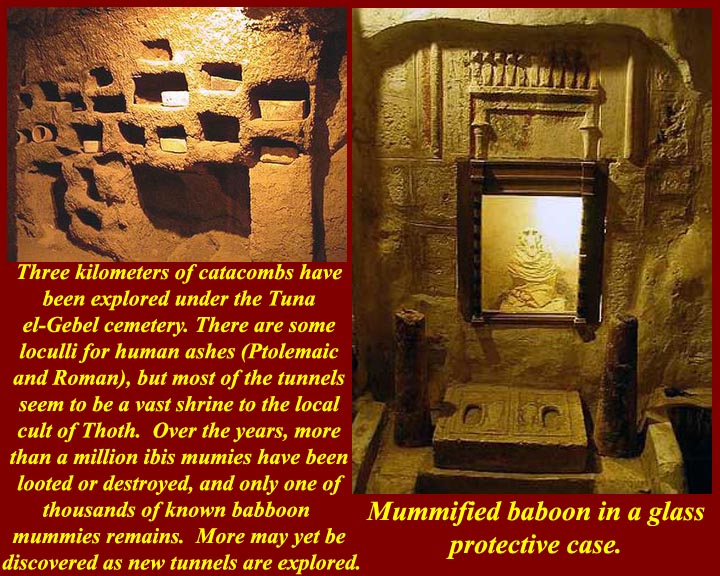
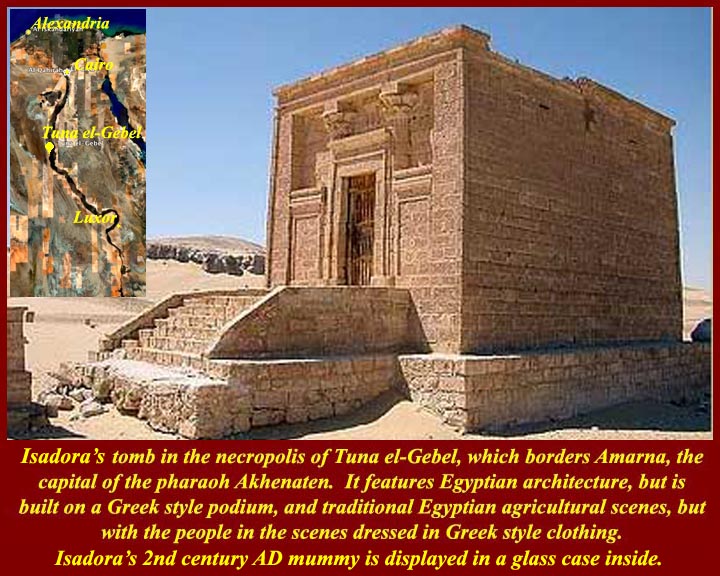
http://www.mmdtkw.org/EGtkw0930TunaNecropolis.jpg
http://www.mmdtkw.org/EGtkw0931TunaCatacombs.jpg
http://www.mmdtkw.org/EGtkw0933TunaRomanTomb.jpg
There are also large necropolises in the interior where local Ptolemaic officials and bureaucrats had their tombs. One of the largest and most interesting is at Hermopolis, ancient Khmun about half way between Cairo and Luxor on the west side of the Nile -- the third image has an inset location map. Hermopolis got its name because the Greeks said that Hermes was the same as Khmun's patron god, Thoth, the Ibis-headed or baboon-headed god of the scribes, who took notes during the weighing of the heart after death. The small part of the huge Khmun/Hermopolis necropolis that has been excavated has produced some interesting tombs and relics. Some Greek tombs have typical Nile River agricultural scenes, but all the people in them are wearing Greek rather than Egyptian clothing. A later Roman period tomb (third image) repeats the same pattern. Isadore, for whome the tomb was built, is displayed under glass inside. The second image shows part of the huge system of catacombs in the necropolis. More than three kilometers have been explored, but few of the side passages have been penetrated. Some of the best faience work ever discovered has been recovered in the tombs and catacombs. Whole sections of the catacombs were found to contain more than a million mummified ibises and thousands of mummified baboons, apparently votive offerings to Thoth. All the ibises and all but one of the baboons were stolen, sold, or destroyed in the years 18th, 19th, and 20th century tourist rush (but there are probably more in unopened parts of the catacombs. The remaining baboon is in a sealed glass box in the catacombs. (C.f.: http://www.touregypt.net/featurestories/tunaelgebel.htm.)
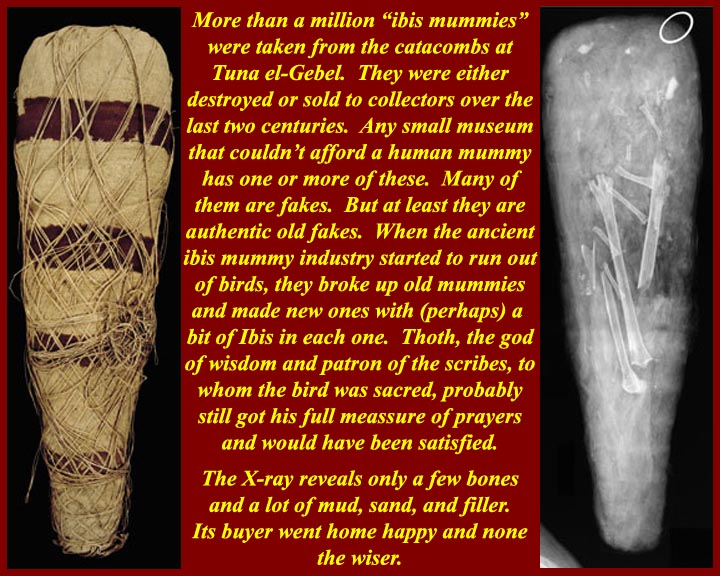
http://www.mmdtkw.org/EGtkw0934TunaIbisFake.jpg
Any museum that couldn't afford a human mummy probably has one or more of the ibises. The odds are that they are fakes. But al least they are authentic ancient fakes. The ancient local ibis mummy industry mass produced pre-wrapped ibis mummies for the ancient priests to sell to ancient adherents of the Thoth cult. The believer was lucky if there was any little bit of an ibis in the bundle. Similar ancient scams were carried out with cats in Bubastis in the delta and with crocodiles at Elephantine Island and at Crocodilopolis in the Fayum. We shouldn't be surprised that modern Egyptian souvenirs might be made in China or Bangladesh -- complete with Egyptian authenticating labels and hallmarks.
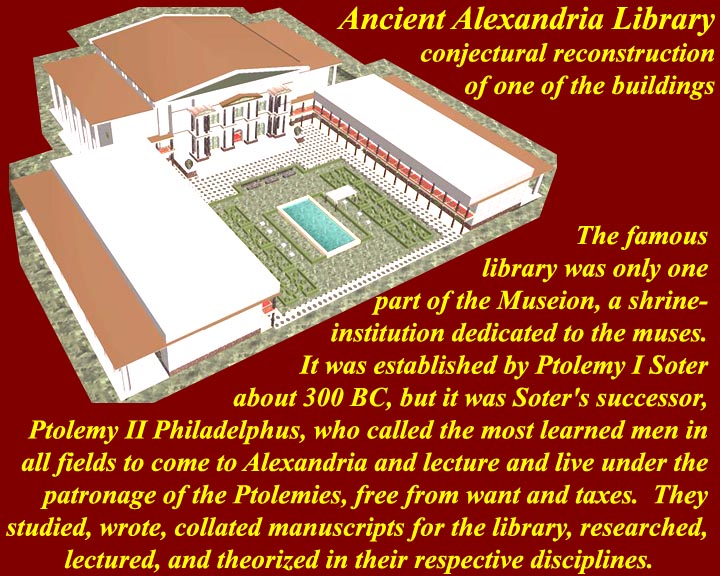
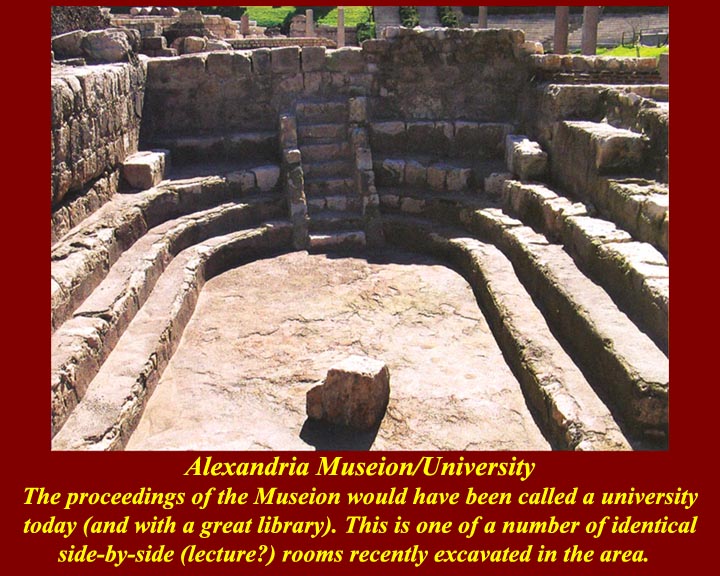
http://www.mmdtkw.org/EGtkw0935Alexandria Museion.jpg
http://www.mmdtkw.org/EGtkw0936AlexLibraryClassroom.jpg
The ancient Alexandria library was justly famous, and it attracted scholars and lecturers from around the Mediterranean. It actually was ore of a university than a simple library although it did have a vast array of written manuscripts. Alexander and his generals were great manuscript thieves and took the collected works of the cities they conquered, many of which ended up at the museion. Properly speaking, the museion was a temple dedicated to the muses and the "librarians" were all priests of the temple. The museion was certainly the best known of the Mediterranean learning centers and almost certainly held the largest manuscript collection in the ancient western world. According to ancient sources, about 50 thousand scrolls burned when Caesar set fire to his ships and the port, but there is no contemporary evidence that it ever happened, nor is there any evidence to back the story that Mark Antony replenished the stock with 100 thousand scroll he allegedly "liberated" from Pergamum. Christians under Patriarch Theophilis were also blamed for destroying the library in 391 AD, but the accounts of his general destruction of temples makes no mention of the library. And why not blame it on the Muslims? According to Christian propagandists writing in 1663 a Muslim army destroyed the library in 642. That story was debunked by other Christians as early as 1713, but the myth persists. So no evidence of any particular destruction of the library exists. It is clear, however, that by the 8th century, the Library was no longer a significant institution and had ceased to function in any important capacity. Alexandria was never a major research center for the Islamic world. Moreover, if the collection had survived to the early 700s, it would very likely have been incorporated into the library of the Al-Azhar mosque (and later university) in Cairo. This collection has come down to the present intact, but does not include Alexandrine texts. The new Bibliotheca Alexandrina (http://www.bibalex.org/aboutus/overview_en.aspx) opened on October 16, 2002.
In 2004, a Polish-Egyptian team found what they believe is a part of the Library while excavating in the Bruchion region of Alexandria just west of the new Alexandrina at the eastern edge of the east bay. The archaeologists unearthed thirteen lecture rooms, each with a central podium. One of the rooms is in the second image. Zahi Hawass, the president of Egypt's Supreme Council of Antiquities, said that all together, the rooms uncovered so far could have seated 5000 students; the picture thus presented is most certainly of a fairly massive research institution, especially for that time.
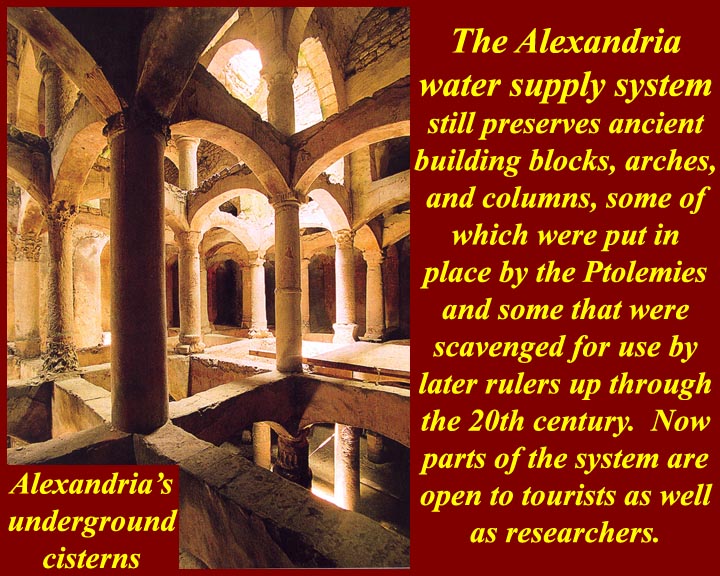
http://www.mmdtkw.org/EGtkw0937AlexCisterns.jpg
Egyptian archeological studies have often been advanced by discovery of re-used architectural elements.
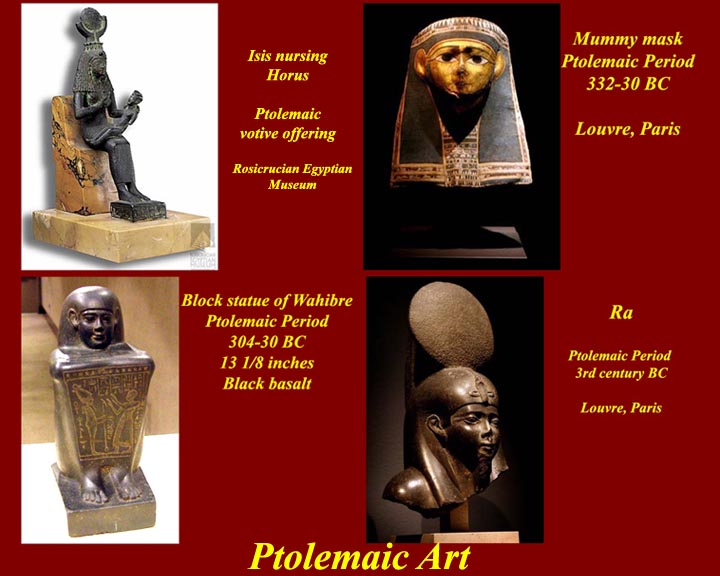
http://www.mmdtkw.org/EGtkw0938PtolemaicArt.jpg
Although the Ptolemies did little that has impressed us politically, their art was up to the standard of previous Egyptian eras.
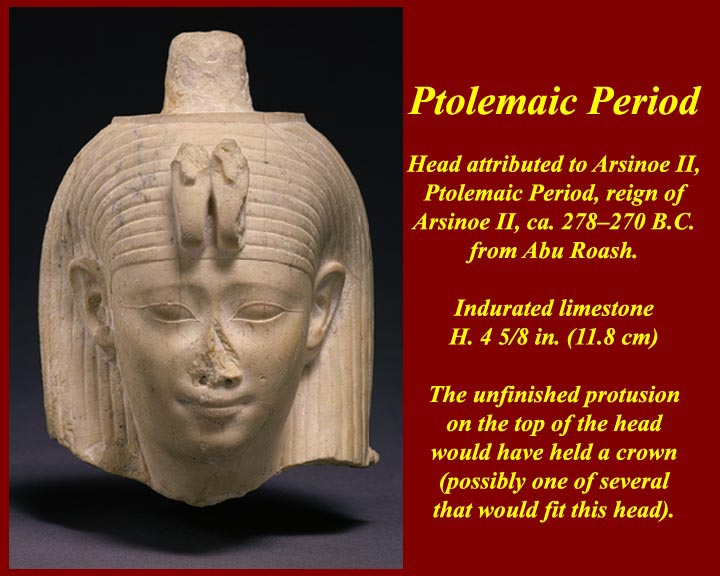
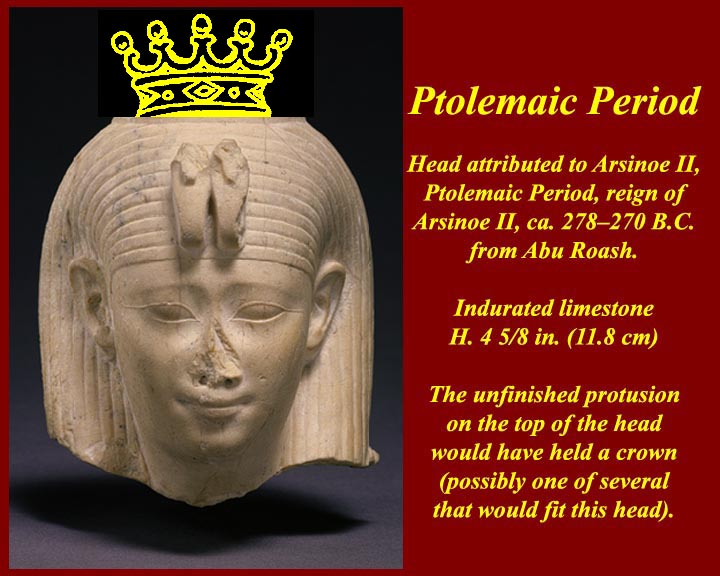
http://www.mmdtkw.org/EGtkw0939ArsinoeIICrownable.jpg
http://www.mmdtkw.org/EGtkw0940ArsinoeIICrowned.jpg
Ancient Roman statues often had interchangeable wigs. This Egyptian statue of Arsinoe II was shaped to take interchangeable crowns.
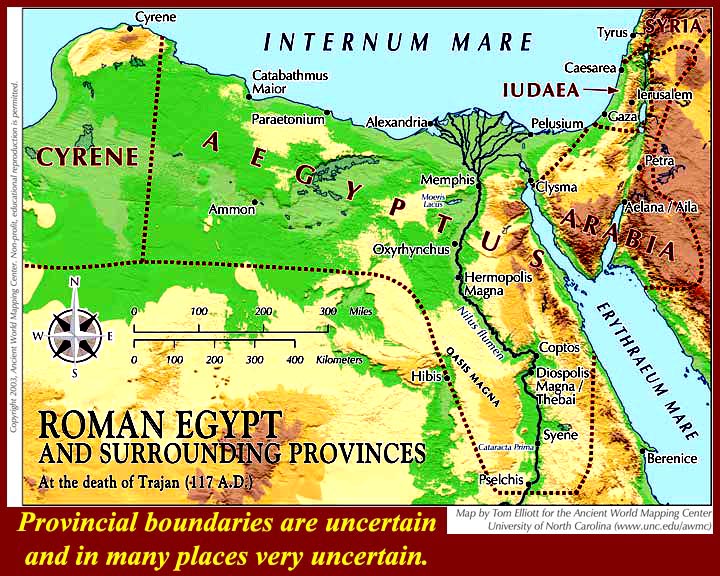
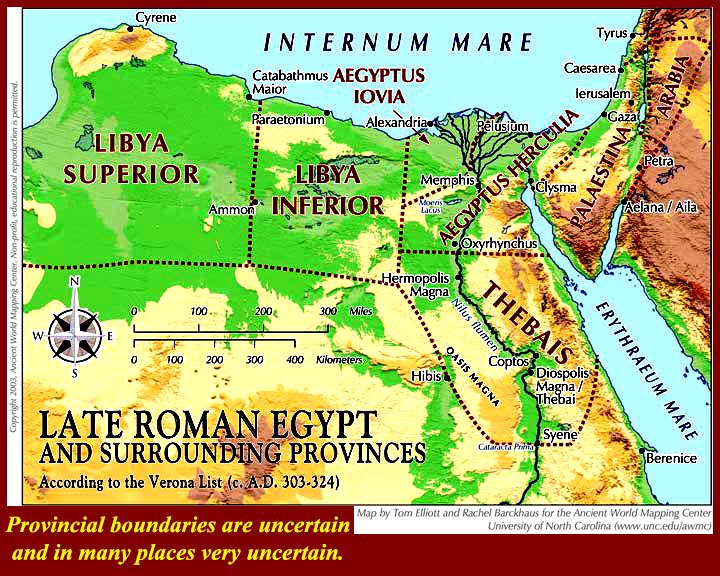
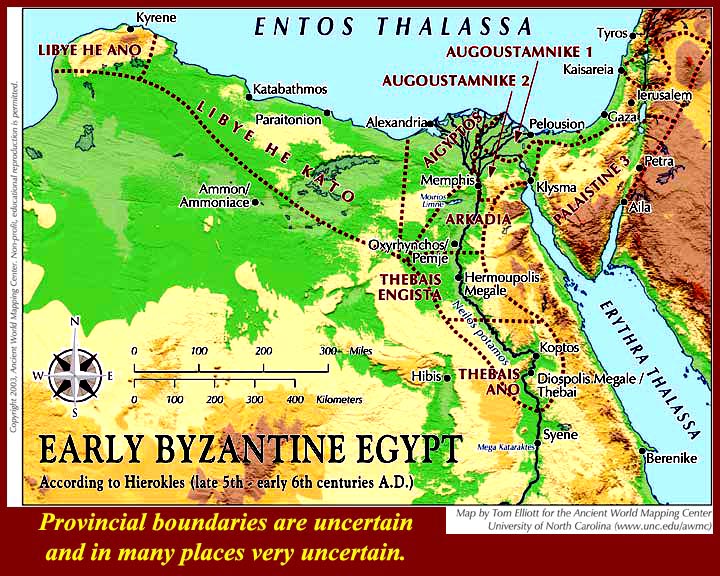
http://www.mmdtkw.org/EGtkw0941EgyptMapRoman.jpg
http://www.mmdtkw.org/EGtkw0942EgyptMapLateRoman.jpg
http://www.mmdtkw.org/EGtkw0943EgyptMapByzantine.jpg
Rome managed to hold on to its Egyptian possessions until the capital of its empire shifted to Constantinople in the 320s AD. Within 150 years, major pieces had slipped away under the Byzantines.
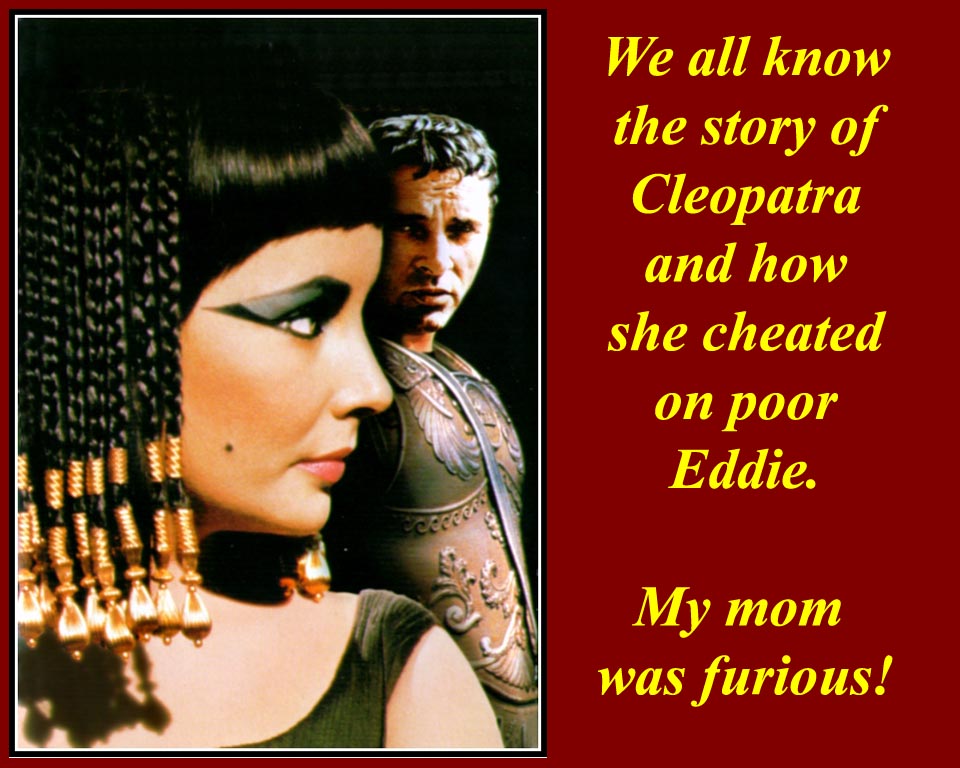
http://www.mmdtkw.org/EGtkw0944CleopatraTaylor.jpg
The image that Americans of a certain age have of Cleopatra are controlled by the stars that portrayed her in movies.
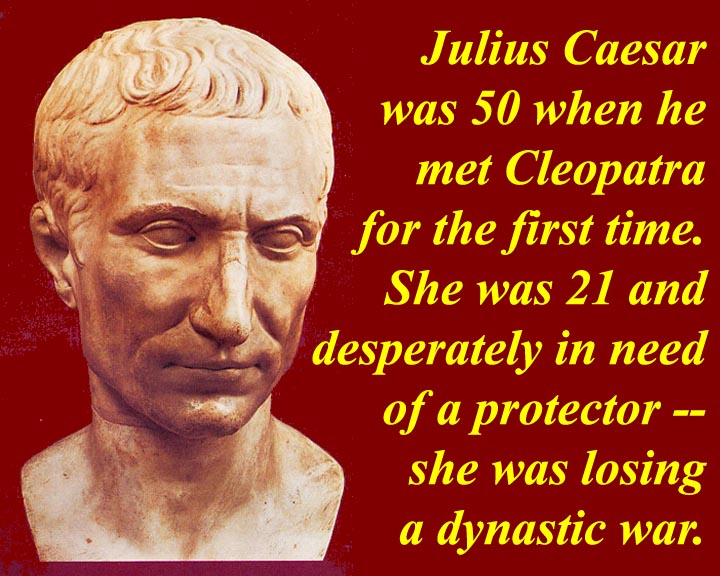
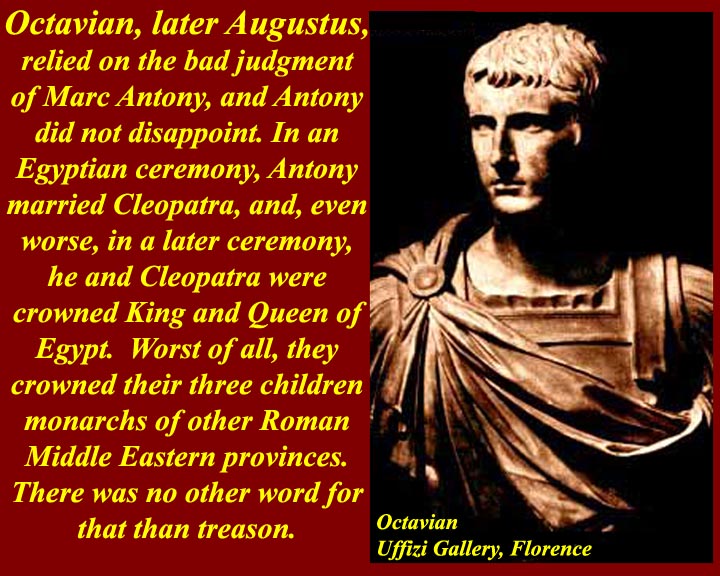
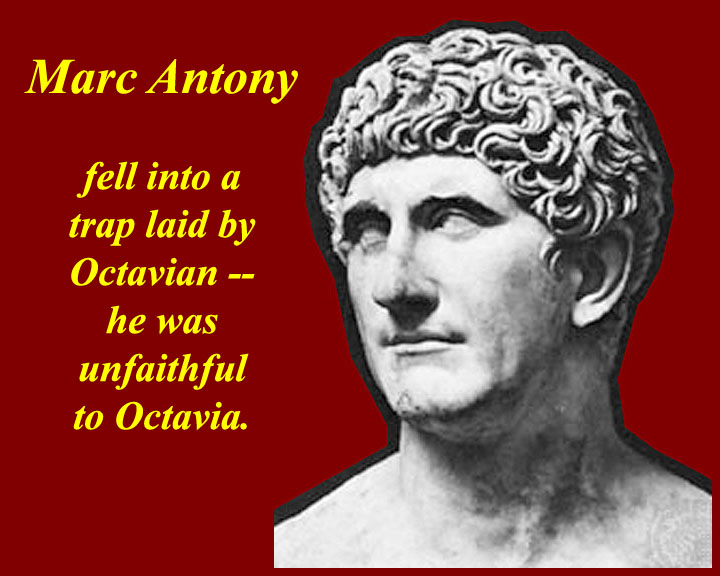
http://www.mmdtkw.org/EGtkw0945JuliusCaesar.jpg
http://www.mmdtkw.org/EGtkw0946Octavian.jpg
http://www.mmdtkw.org/EGtkw0947MarcAntony.jpg
http://www.mmdtkw.org/EGtkw0948Agrippa.JPG
The men in Cleo's life -- and death. The first image is Julius, who gave her a child, a house in Trastevere, and a quick exit from Rome when he was assassinated. One of the reasons for his assassination was his affair with Cleo which scandalized Rome. The second image is Octavian who later became Augustus and ruled an empire greater than that of Alexander after he defeated Cleo and Mark Antony. The third is Antony who gave her two sons and a daughter and whose own suicide led to her rendezvous with the asp. The fourth is Agrippa who really won all of Octavian's battles for him. Agrippa was slated to be the successor of Augustus, but Augustus lived a longer than normal life and outlived Agrippa and several other heirs apparent.
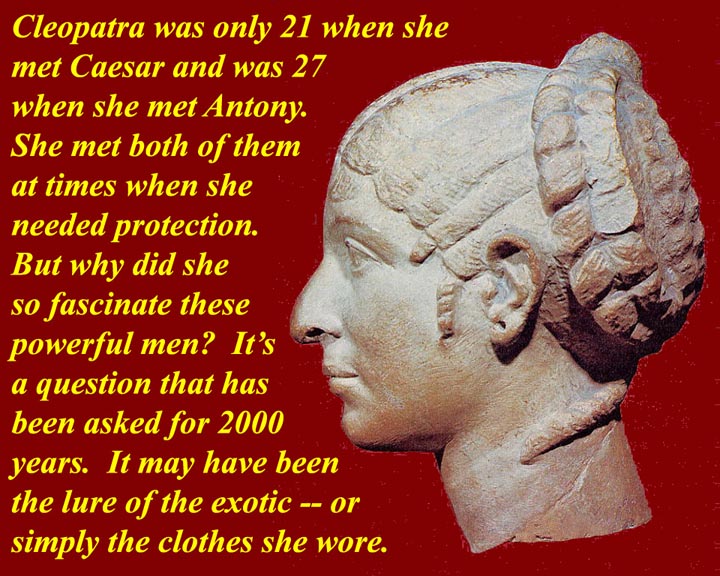
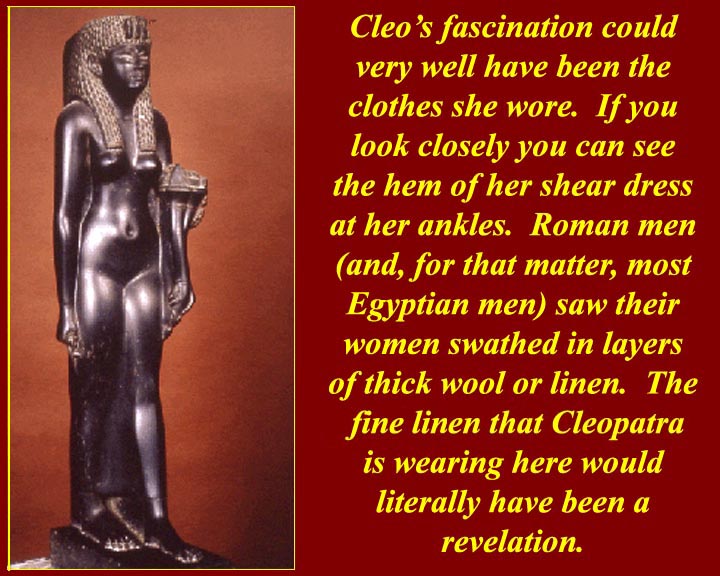
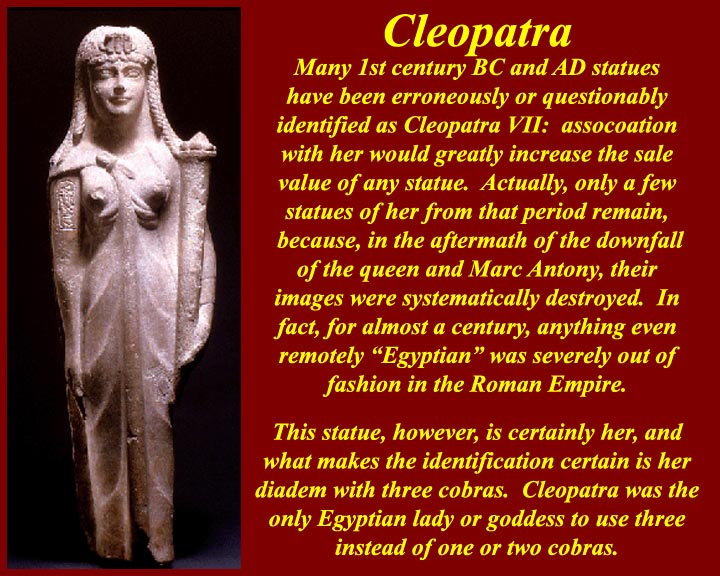
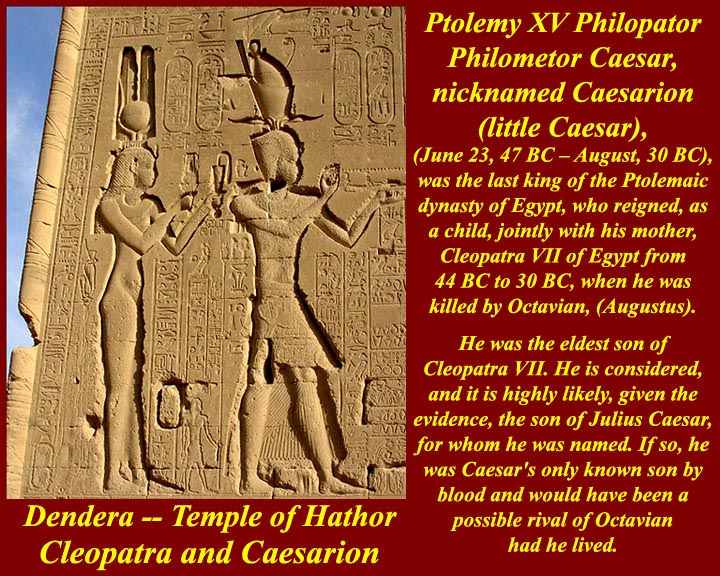
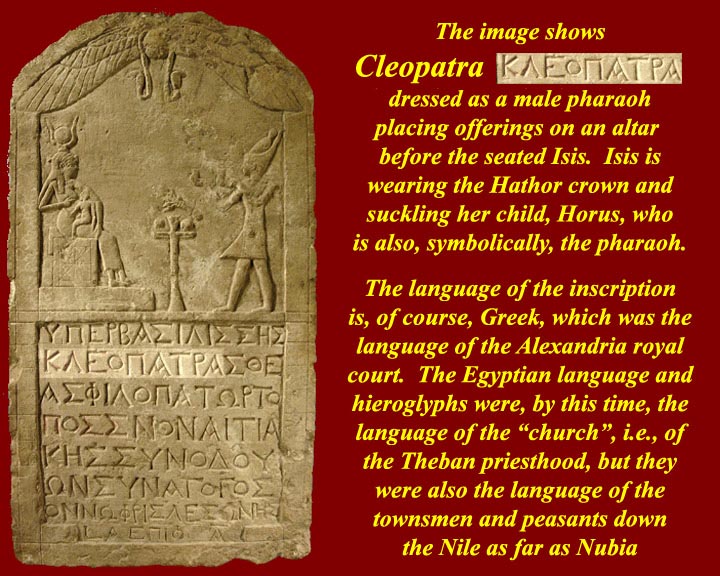
http://www.mmdtkw.org/EGtkw0949CleopatraProfile.jpg
http://www.mmdtkw.org/EGtkw0950CleopatraClothes.jpg
http://www.mmdtkw.org/EGtkw0951Cleopatra1.jpg
http://www.mmdtkw.org/EGtkw0952CleoCesarionDenderaHathorTemple.jpg
http://www.mmdtkw.org/EGtkw0953CleopatraIsisLouvre.jpg
As did her predecessors, Cleopatra adopted the garb that would please the audience. Several of her portrait busts and statues show that she was no raving beauty, so what was her attraction for the roman generals? Part of it would have been the lure of the exotic -- check out her tight transparent gown in the second image. But there was also the fact that, with the help of the Roman generals, she could control one of the wealthiest granaries in the area. A young rich woman in exotic clothes might just be what a war weary general was looking for.
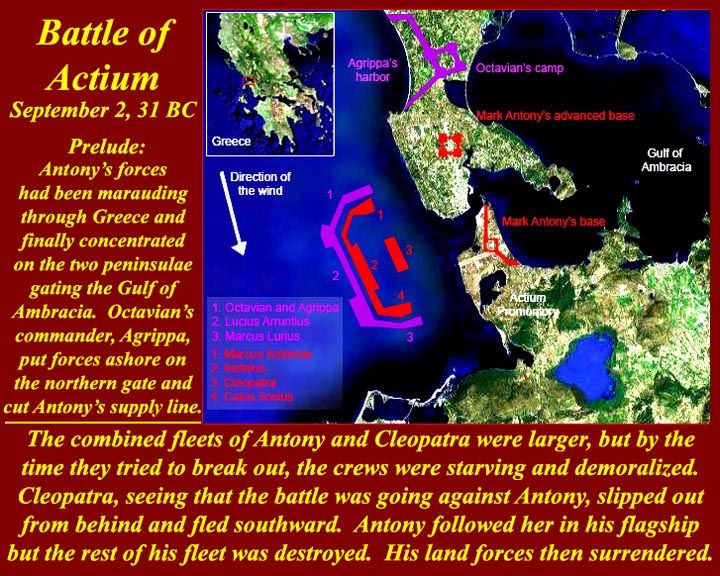
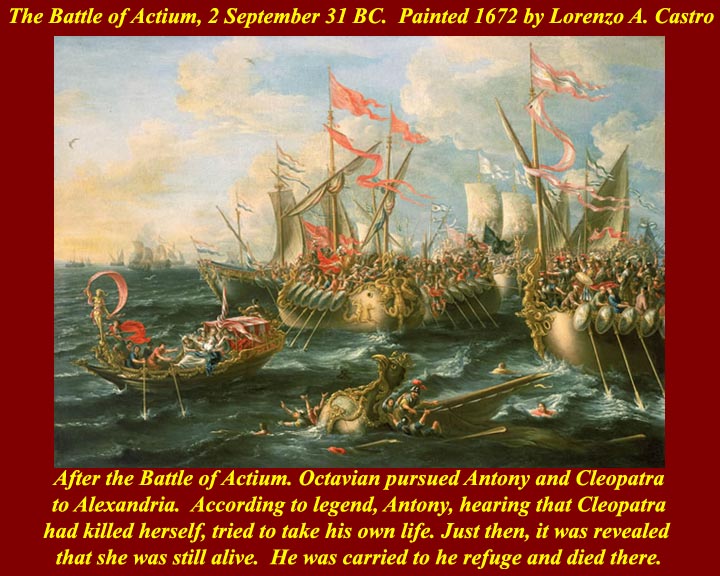
http://www.mmdtkw.org/EGtkw0954BattleActium.jpg
http://www.mmdtkw.org/EGtkw0955CastroBattleActium.jpg
The battle of Actium is remembered as a sea battle, but land maneuvers had set it up. Octavian's forces under General Agrippa had bottled up the forces of Antony on the Actium promontory, the southern of two peninsulae that sheltered the Gulf of Ambracia where the fleet of Antony was riding with that of Cleopatra. Eventually, to escape starvation, the fleets of Antony and Cleopatra tried to run through Admiral Agrippa's naval blockade. (Yes, the same Agrippa.) Cleopatra and part of her fleet slipped past the southern end of the blockade, but Antony's fleet was trapped. Instead of leading his fleet into honorable defeat, Antony turned his flagship off the line and fled behind Cleopatra. Antony's fleet was defeated, and the remnant of the fleet along with his land forces not only surrendered but joined the forces of Octavian: they were disgusted with Antony's desertion. Antony and Cleopatra fled to Alexandria followed by Octavian and the now combined fleets and armies. Antony and Cleopatra could not muster an effective defensive force, and Alexandria was soon taken. Their suicides ended their drama, but there were a few more loose ends. Cleopatra's son by Julius Caesar, though still a child, had been Cleopatra's co-pharaoh and had to be eliminated to end both the Ptolemaic Egyptian line and to prevent him from potentially becoming a pawn for Octavian's enemies. Her three children with Antony were spared and brought back to Rome where they were put in the care of Octavia, who was Octavian's sister and Antony's Roman wife and who, now a widow, was living in Octavian's household. The two boys disappeared and it's assumed they were assassinated.
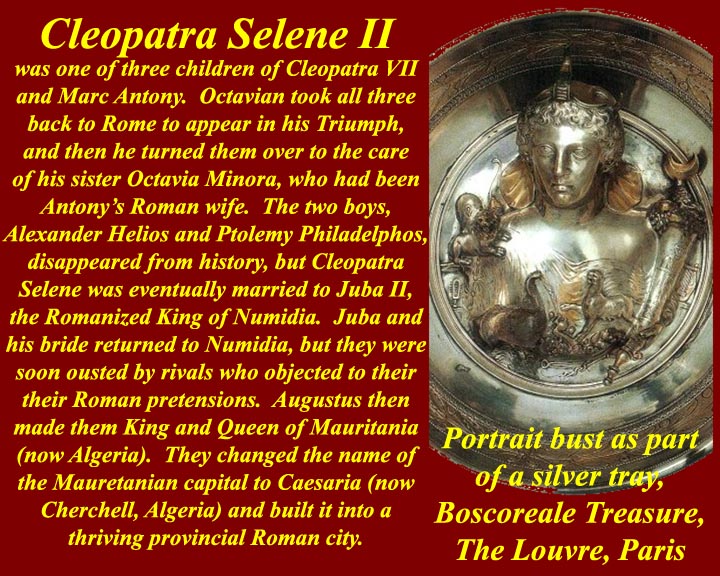
http://www.mmdtkw.org/EGtkw0956CleopatraSelene.jpg
The Daughter of Cleopatra VII was Cleopatra Selene, sometimes listed as Cleopatra VIII. Eventually Octavian married her off to Juba II, a Numidian prince/hostage, with whom she had apparently fallen in love. Together, Cleo Selene and Juba II founded the successful North African Mauritanian metropolis of Caesaria (now Cherchell, Algeria).
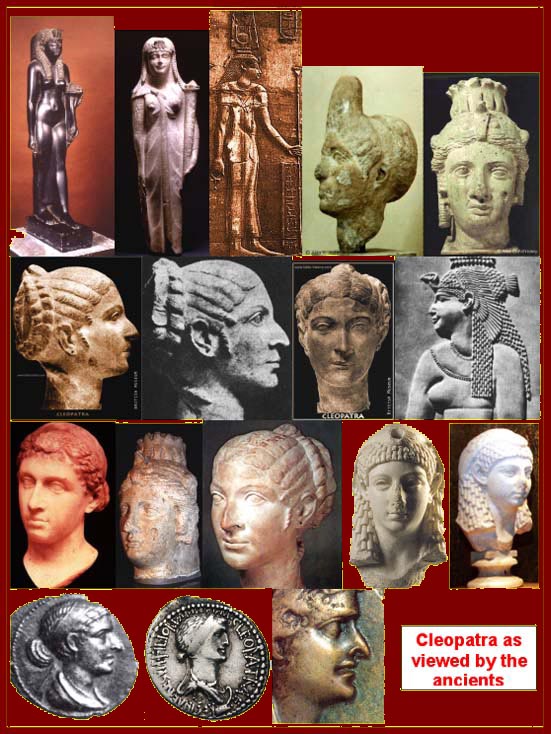
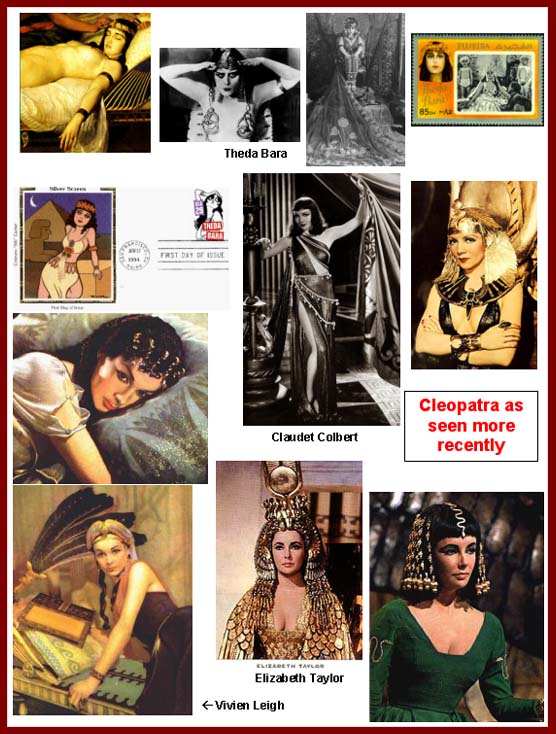
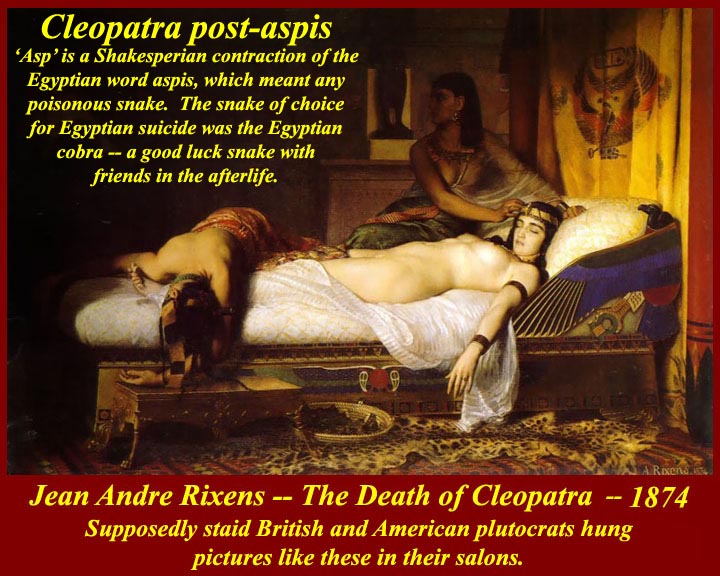
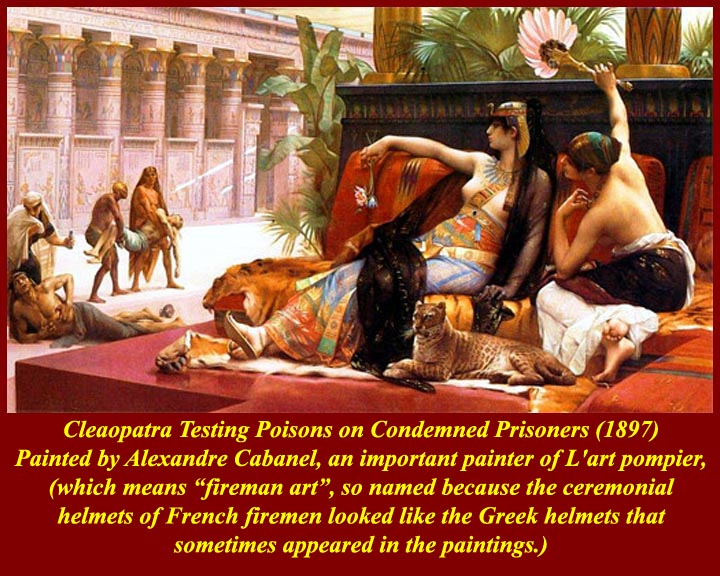
http://www.mmdtkw.org/EGtkw0957AncientCleos.jpg
http://www.mmdtkw.org/EGtkw0958ModernCleos.jpg
http://www.mmdtkw.org/EGtkw0959CleopatraPostAspis.jpg
http://www.mmdtkw.org/EGtkw0960AlexanderCabanelCleopatraVII.jpg
There are only a few well attested statues of Cleopatra VII anywhere. After her defeat the Romans systematically destroyed them in a process called damnatio memoriae, damnation of the memory. There are plenty of modern Cleopatra's, however, including the movie Cleos in the second image and the "dirty pictures" kind that masqueraded as "art with a classical theme" in the drawing rooms of the rich in the 19th and early 20th centuries. The fourth image has a very authentic looking Ptolemaic temple in the background. It was done by Alexandre Cabanel school of art called L'art Pompier (fireman art), because the helmets of Greek and Roman soldiers, who sometimes appeared in the pictures, so closely resembled the helmets of Parisian firemen.
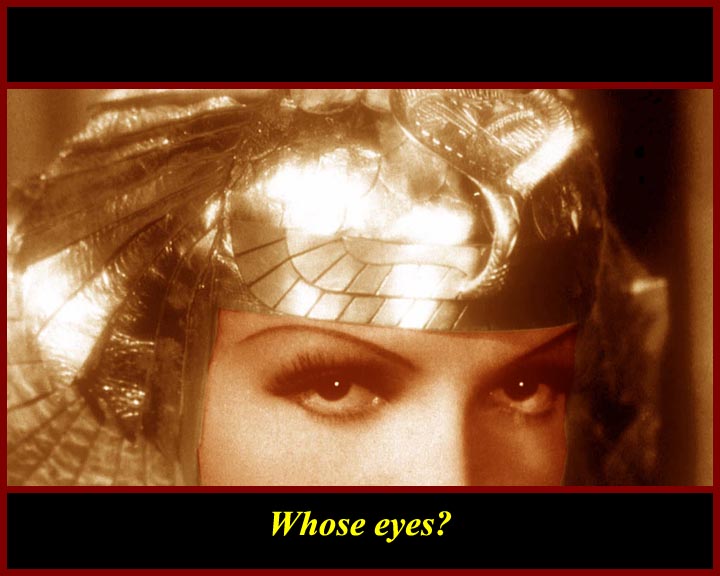
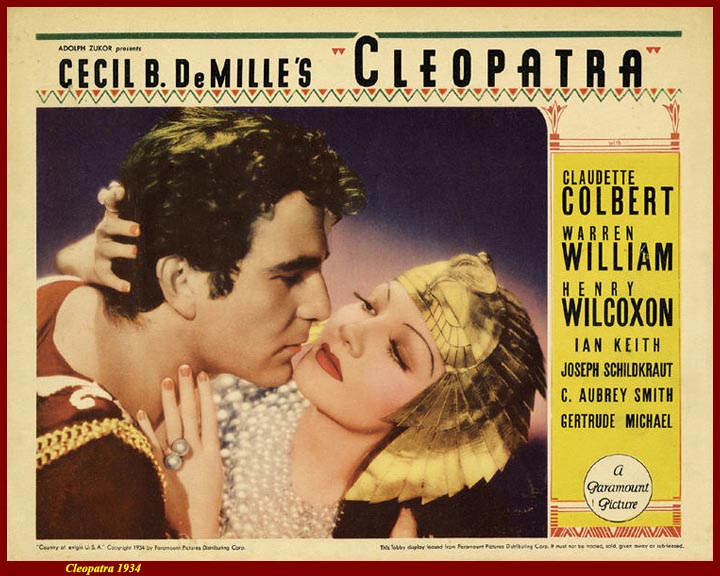
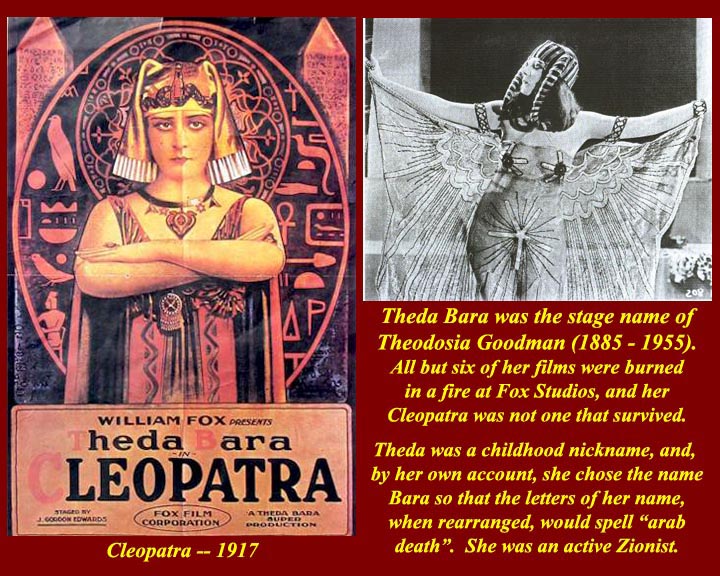
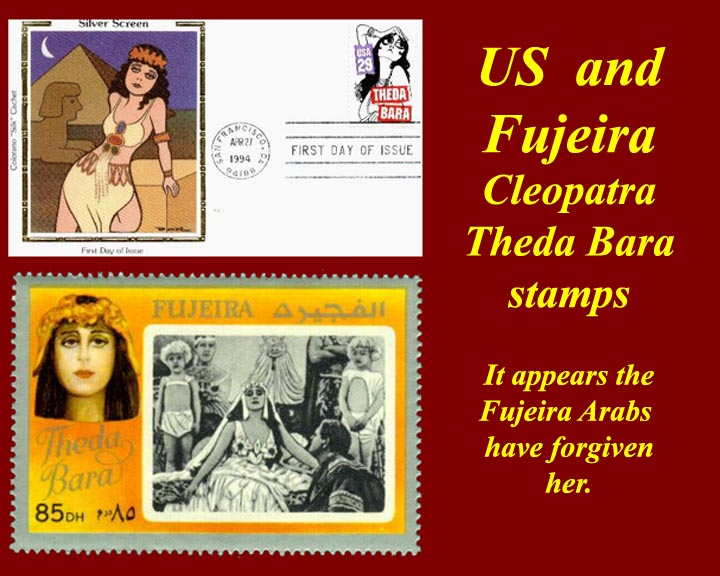
http://www.mmdtkw.org/EGtkw0961CleoEyesColbert.jpg
http://www.mmdtkw.org/EGtkw0962CleoColbert.jpg
http://www.mmdtkw.org/EGtkw0963CleoTheda.jpg
http://www.mmdtkw.org/EGtkw0964ThedaCleoStamp2.jpg
Cleo went to the movies several times. neither Claudette Colbert nor Theda Bara needed the eye makeup that Elizabeth Taylor wore.
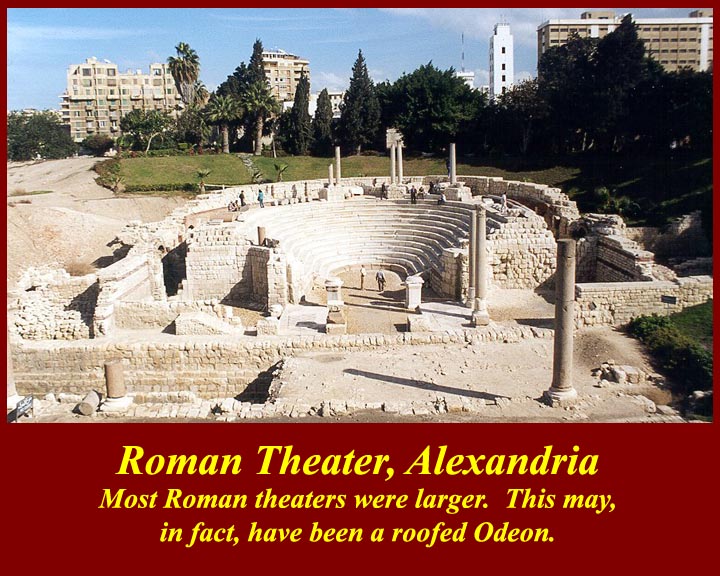
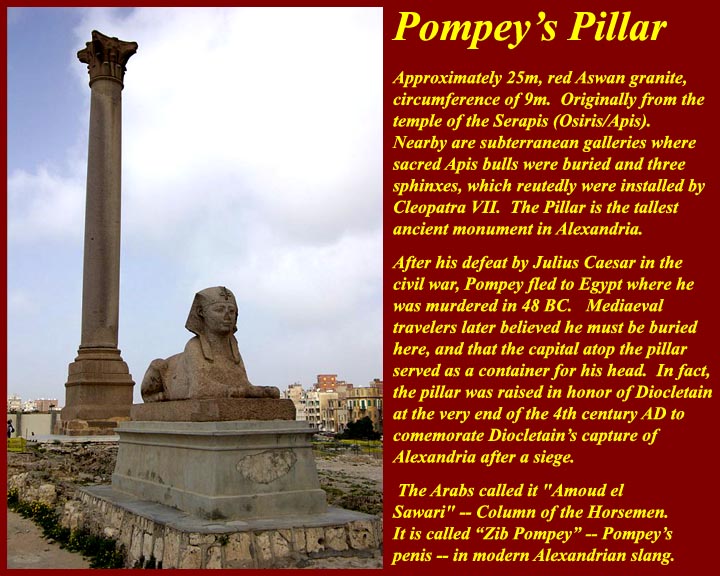
http://www.mmdtkw.org/EGtkw0965AlexandriaRomanTheater.jpg
http://www.mmdtkw.org/EGtkw0966PompeysPillar.jpg
The ancient Romans did in Alexandria what ancient Romans did wherever they went, but with just enough local flavor to keep the indegenes happy. And besides, after a short period of anti-Egyptian propaganda associated with the war against Antony and Cleopatra, ancient Roman Egyptianisme became de rigueur again tout de suite -- like mixing French in with English to sound educated.
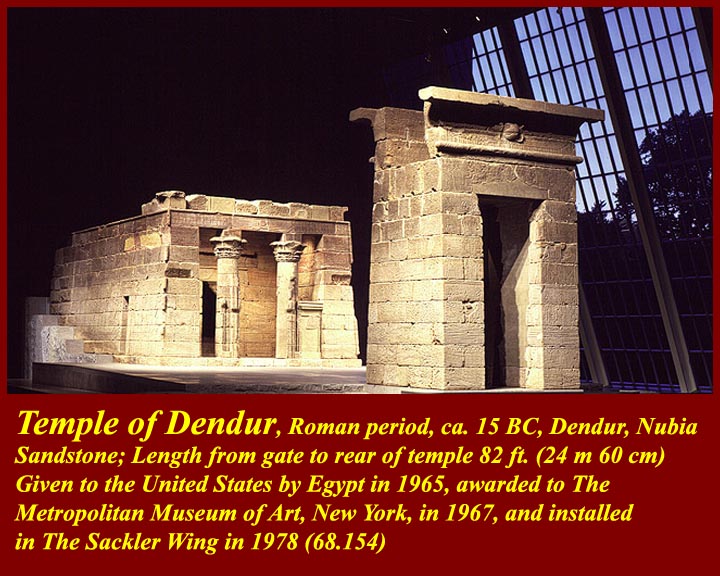
http://www.mmdtkw.org/EGtkw0968DendurTemple.jpg
Roman temples in Egypt were built on the Ptolemaic model. This small one is in the Metropolitan Museum in New York.
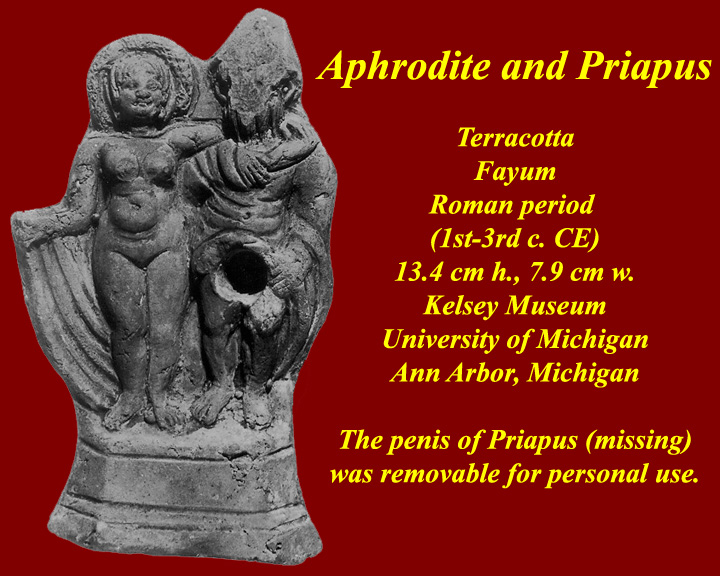
http://www.mmdtkw.org/EGtkw0969AphroditePriapus.jpg
When far from home, the Romans liked to have a little something to remind them of home and of who they really were. This terracotta sex toy, found in the Fayum (ubfortunately incomplete), nicely filled the requirement.
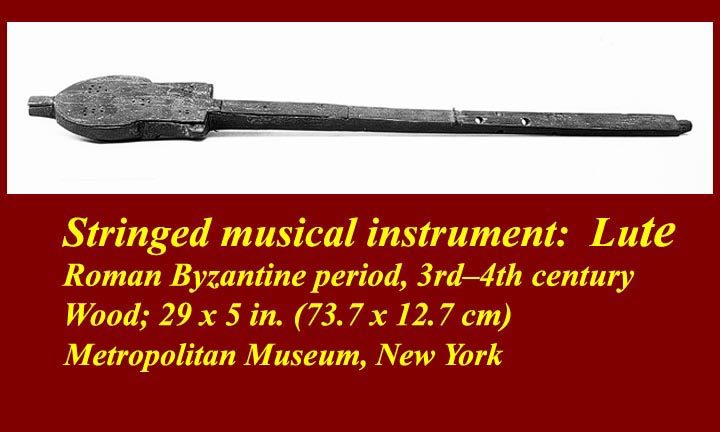
http://www.mmdtkw.org/EGtkw0970Lute.jpg
And they liked background music.
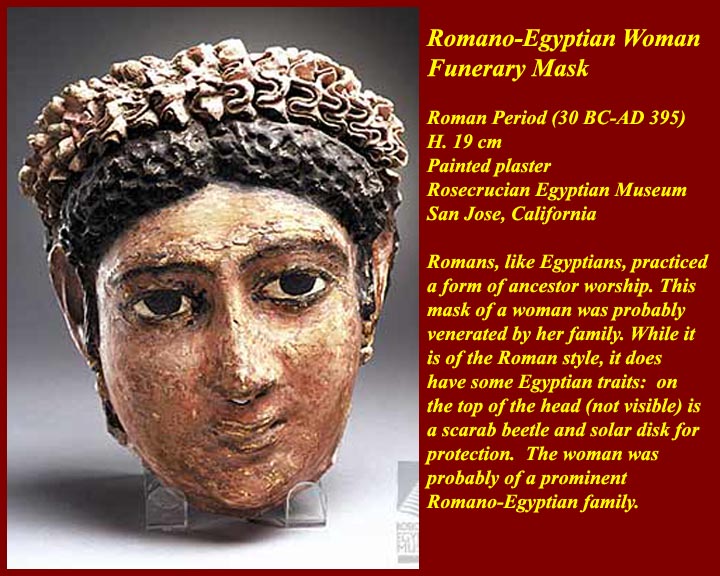
http://www.mmdtkw.org/EGtkw0971FuneraryMask.jpg
The Romans had a tradition of funerary ancestor masks long befor they went into Egypt. They often were molded life masks or death masks and they were worn or carried in Roman funerals. In Egypt, that tradition merged with the old Egyptian and newer Ptolemaic traditions of placing a mask on the mummy. Many Roman death rituals ended in cremations, but among Roman Christians and Roman Isis worshippers mummification and interment were more common. (We'll get to the Roman Isis worshippers in a little bit.)
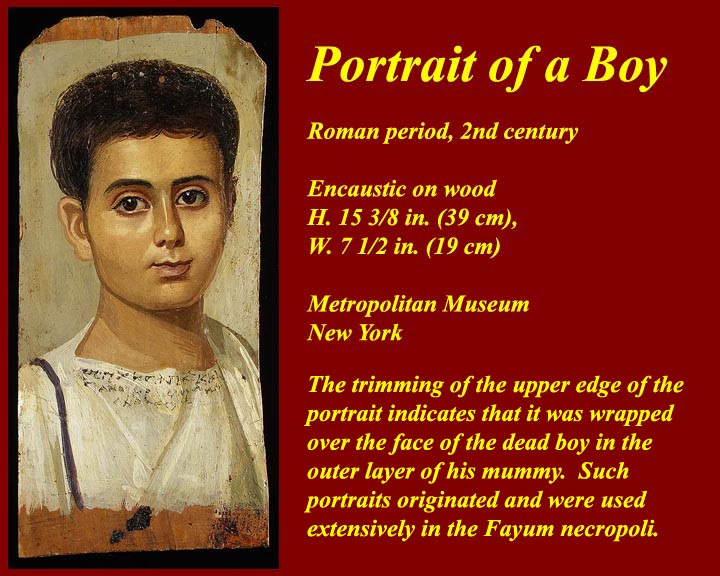
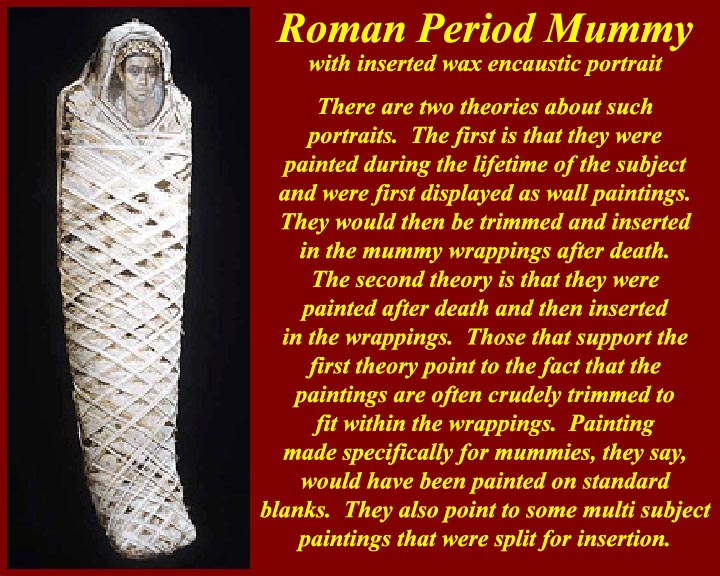
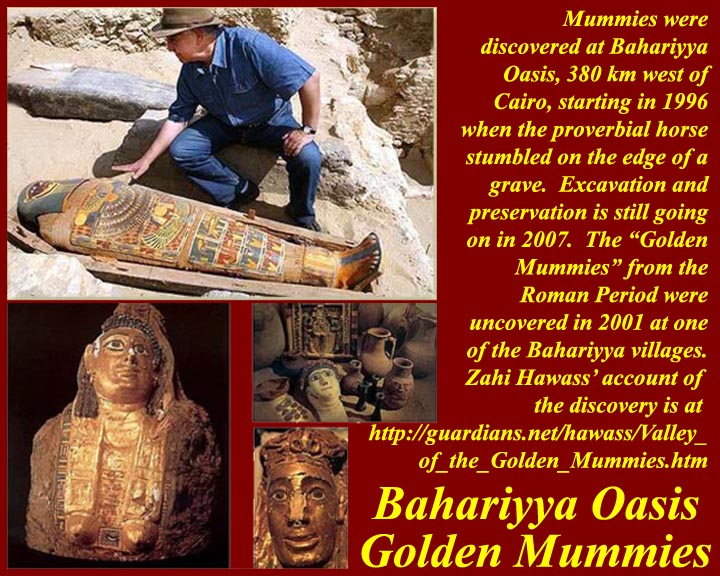
http://www.mmdtkw.org/EGtkw0973MummyPortrait.jpg
http://www.mmdtkw.org/EGtkw0974PortraitMummy.jpg
http://www.mmdtkw.org/EGtkw0975GoldenMummies.jpg
In the Fayum during the Roman period, a tradition developed of wrapping wood panel portraits painted mostly in encaustic (i.e., beeswax as the medium to apply the pigment) into the outer layer of mummy wrappings over the fave of the deceased. In other oases, fully modeled cartonage masks continued to be used and many, especially from the Bahariyya Oasis are covered in gold leaf, which indicates the wealth of those communities. The third image shows Zahi Hawass with what he has described as the most beautiful mummy ever excavated in Egypt. (I'd hope he's actually talking about the case.) (http://guardians.net/hawass/Valley_of_the_Golden_Mummies.htm)
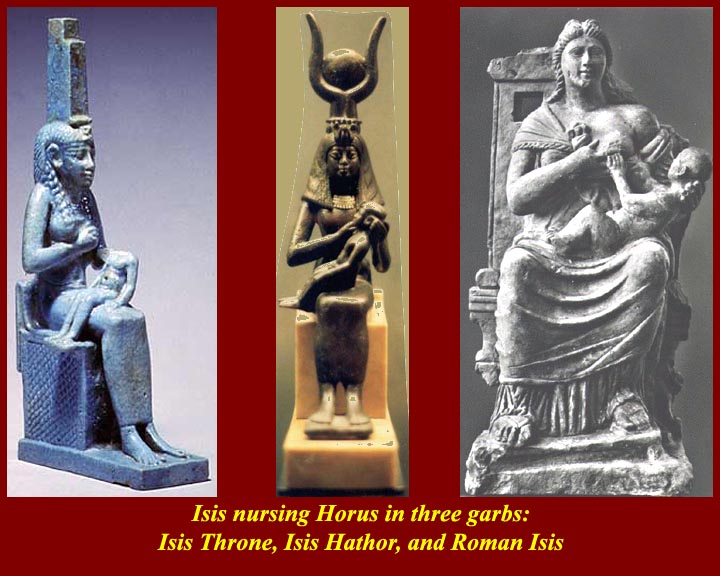
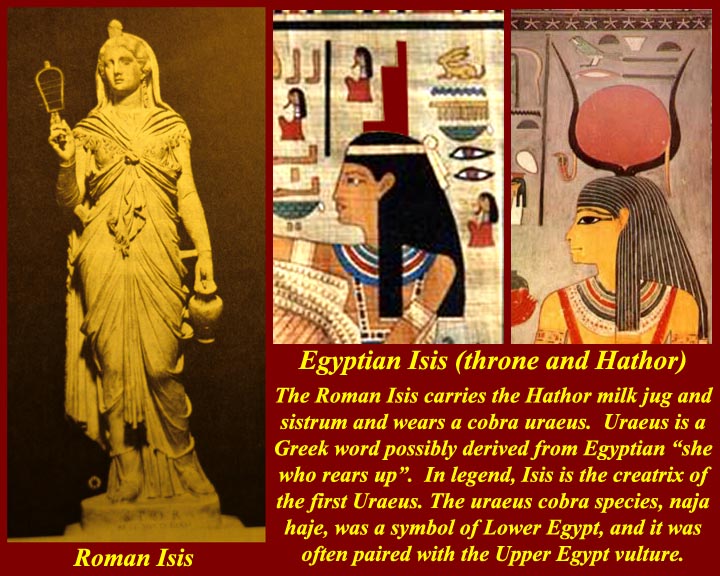
http://www.mmdtkw.org/EGtkw0976IsisTheeGarbs.jpg
http://www.mmdtkw.org/EGtkw0977Isisx3.jpg
Isis worship was reinvigorated by the Romans and was taken by the Roman armies as far away from Egypt as an Isis temple at Hadrian's wall in England. The Isis of the Romans, however had little in common with the first Egyptian Isis who was the personification of the throne (or, more figuratively, support) of the pharaoh. That wasn't much of a problem, however, because the Egyptians were accustomed to metamorphosis of their gods -- even the Egyptian Isis was no longer as much Throne as she was Hathor. On he first image we see Isis moving through her Egyptian and classical phases, and in the second we see Isis as a full round Roman statue with Hathor's sistrum and jug, the Egyptian uraeus in her forehead and nothing indicating the source of her name, which literally meant throne.
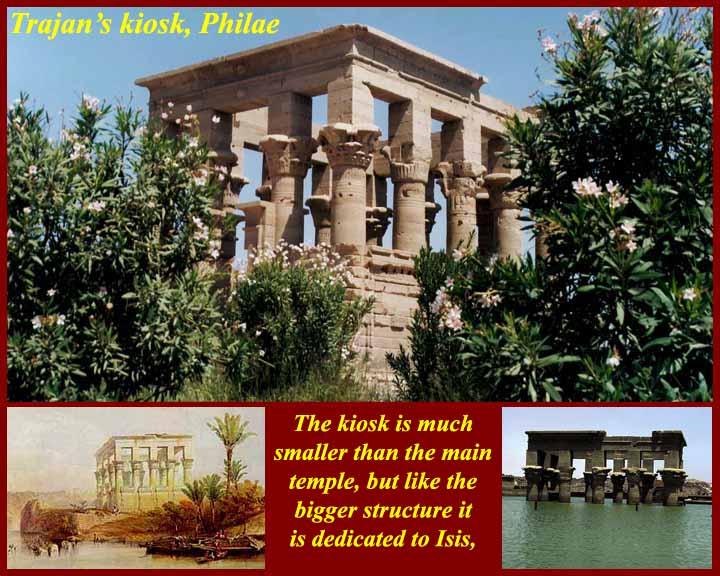
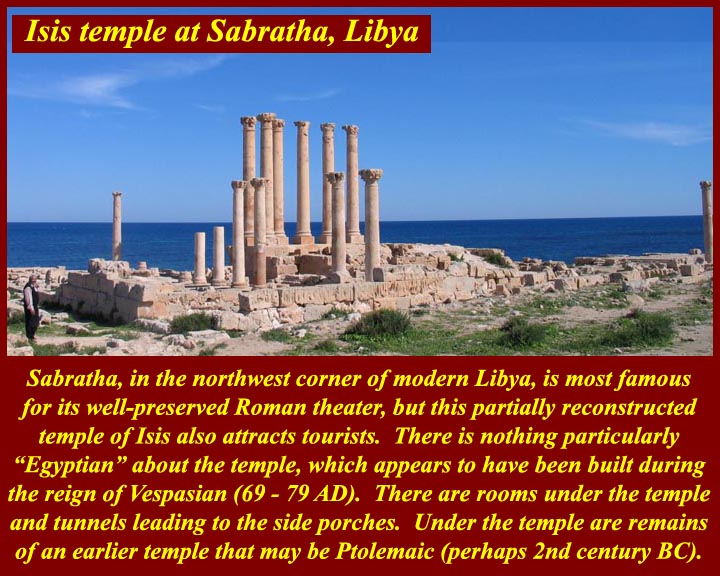
http://www.mmdtkw.org/EGtkw0978TrajanKioskPhilae.jpg
http://www.mmdtkw.org/EGtkw0979SabrathaIsis.jpg
The Trajan Kiosk, a small Isis temple in the Philae Isis temple comlex, and the large Isis temple in Sabratha, west of Tripoli in Rome's Tripolitania North African province.
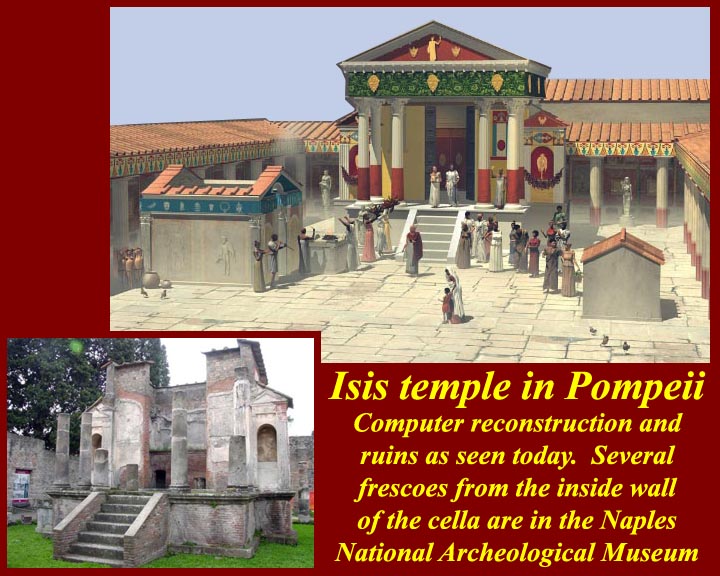
http://www.mmdtkw.org/EGtkw0980IsisTemplePompeii.jpg
Image: http://www.ancientvine.com/templeofisis.html used with kind permission of AncientVine -- see http://ancientvine.com/index.html for more from this great site.)Isis worship was very popular in Pompeii and in other towns in the Roman Campania where it may have been introduced by Greek seamen, who took to Isis worship early on, or by Egyptian merchants -- the Bay of Naples was the entrepot for Rome's foreign trade including trade with Egypt. The reason we know of the populaarity of Isis in Pompeii is that hers was the only big temple that had been quickly and completely rebuilt between the time of the eartquakes that almost destroyed the city in the early 60s AD and the final destruction by the eruption of Vesuvius in 79 AD. All the other temples were either only partially restored or not restored at all. Isis worship, in fact, may have led to the ignorance of the Pompeians of the danger under which they lived. The local (i.e., non-Isis) mythology of the region around Pompeii and Neapolis was mostly Greek, and it spoke of the burial of the rebellious Giant Mimas under Mt. Soma by Haephestos, a Greek fire god -- Soma was one name of pre-Eruption Vesuvius. When Mimas was restless, earthquakes and eruptions resulted. As reinforcement of the myth, the brother of Mimas, another rebellious giant named Encelados, was said to be burried under the perennially erupting Mt. Etna in Sicily. It's often said, by the way that the Romans had no word for volcano and so were ignorant of the dangers of Vesuvius. neither part of that is true. Roman scholars were aware that Vesuvius was volcanic, and they had adopted a perfectly good Greek word to use for volcano, that word being "etna". At any rate, although Roman scholars might have known all about the dangers of the volcano, the common folks around its base were unaware, having forgotten their local mythology when they took up with that foreign goddess, Isis.
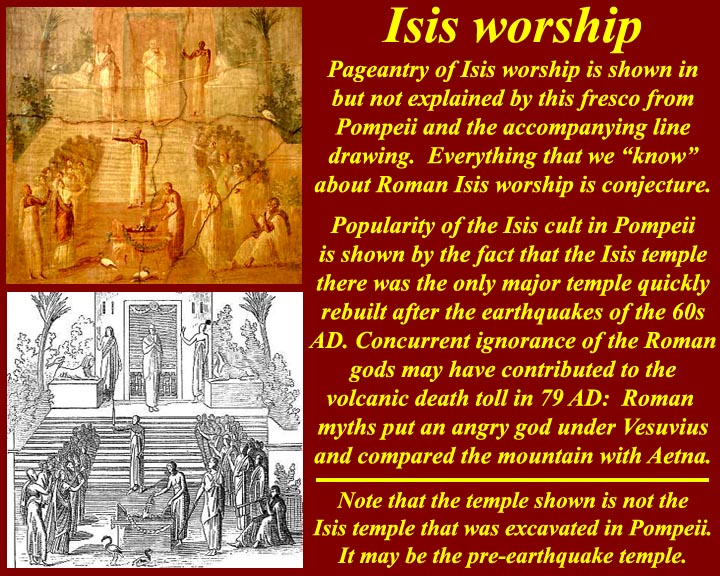
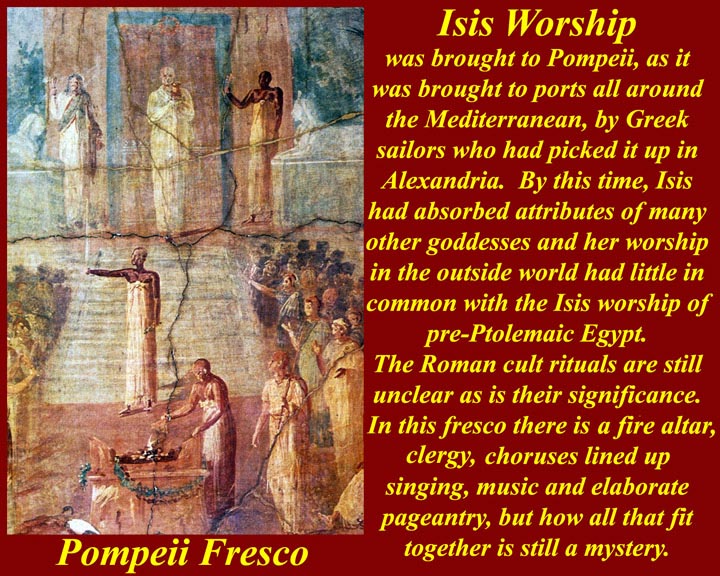
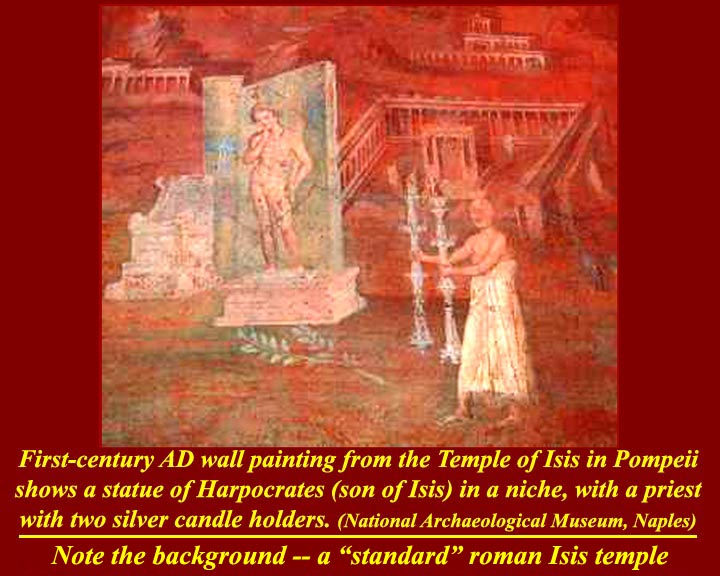
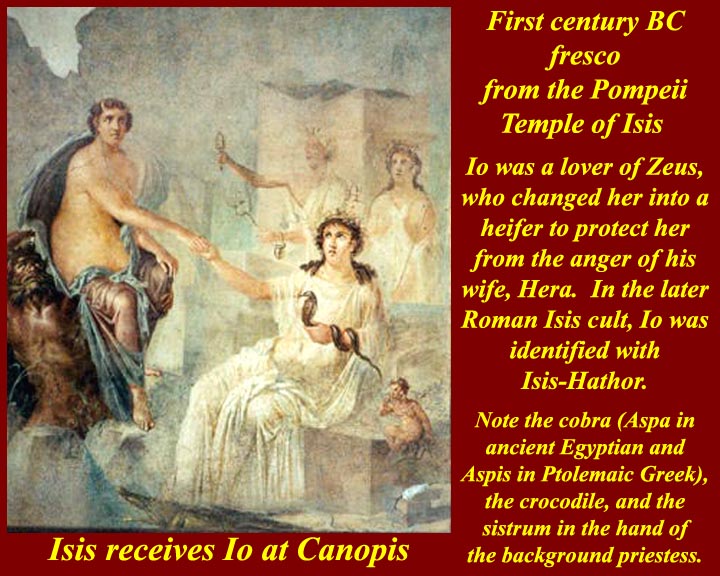
http://www.mmdtkw.org/EGtkw0981IsisWorship1.jpg
http://www.mmdtkw.org/EGtkw0982IsisWorship2.jpg
http://www.mmdtkw.org/EGtkw0983PompeiiIsisTempleFresco1.jpg
http://www.mmdtkw.org/EGtkw0984PompeiiIsisTempleFresco2.jpg
Nor much is really known about Roman Isis Ritual. All we have are a few frescoes taken from the inside walls of the Isis temple in Pompeii and some suspicious tunnels leading under that Isis temple in Sabratha. No "villa of the mysteries" has been found to match the one outside of Pompeii that apparently showed the initiation rite of the Dionysian mystery cult. Nor did the religion become so widespread and dominant that large the mysteries ceased to be mysterious as happened with Christianity. Isis worship, Mithraism, and the religion of the Eleusian mysteries, died without revealing their secrets. However ---- there are several modern Isis religions that claim to have either new revelations of to have unlocked the old secrets. Unless one becomes an initiate, there is no way to know whether they are authentic.
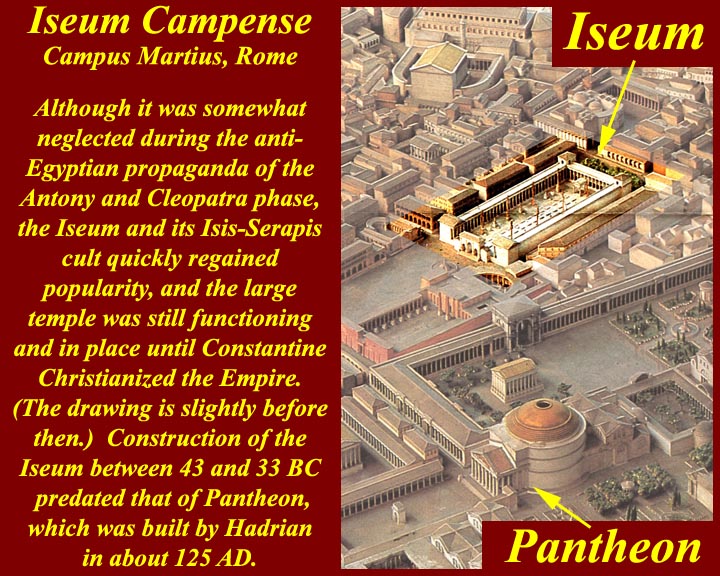
http://www.mmdtkw.org/EGtkw0985IseumRomeDrawing.jpg
From the time of Augustus until all the temples were suppressed by Gratian and Theodosius in the latter half of the 4th century AD, a large temple of Isis, the Iseum Campense, stood just three blocks from the Pantheon in Rome's Campus Martius. There were occasional persecutions which intensified after Constantine's Edict of Milan, which ostensibly allowed all religions to function in Rome's empire. In 380, Theodosius issued the Edict of Thessalonika which called for the closing of all non Christian religious sites, but it wasn't until 536 AD that the emperor Justinian (483-565) ordered the closing of the last temple of Isis, situated in the island of Philae on the Nile at the borders with the Nubia, and made it turn into a Christian church. The plan plan of the Iseum Campense is well delimited, and several of the obelisks that graced its front court still ornament the city: one is the centerpiece of the fountain right in front of the Pantheon and another stands on the back of Bernini's famous Elephant in front of Santa Maria Sopra Minerva, just behind and to the left of the Pantheon. When it was in operation it was a big temple and was clearly well funded either by rich donors or by a large congregation.
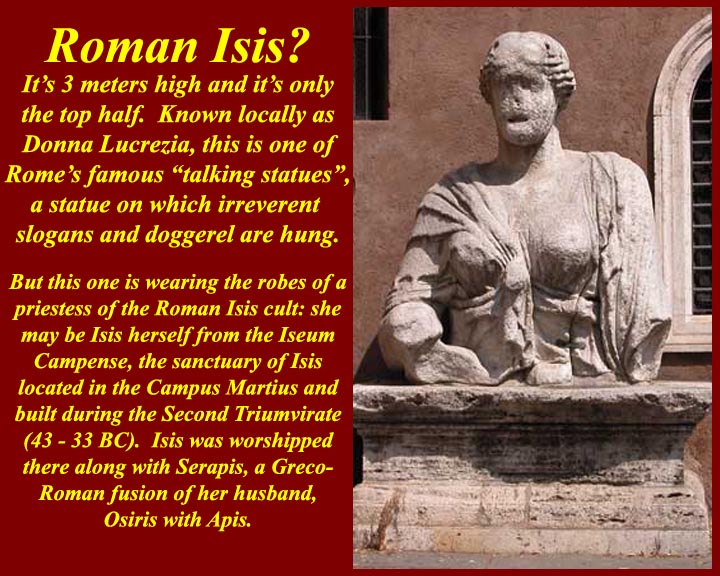
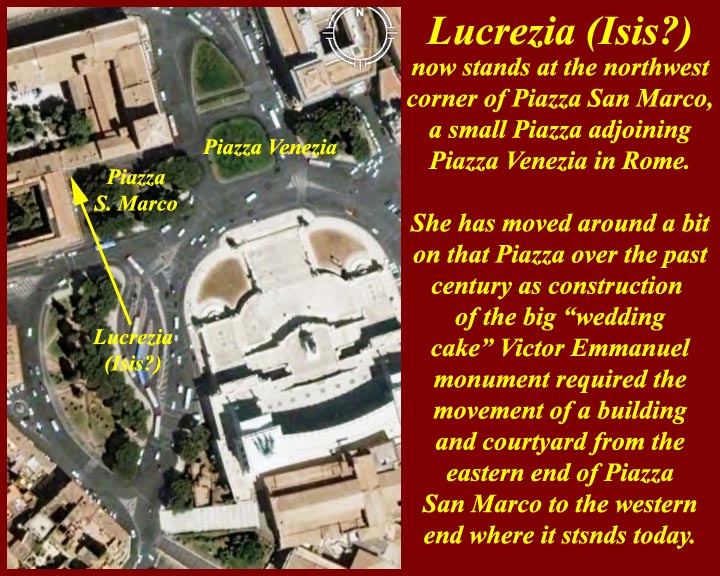
http://www.mmdtkw.org/EGtkw0986IsisLucrezia.jpg
http://www.mmdtkw.org/EGtkw0987IsisLucreziaLocator.jpg
There's a good chance that Isis is still in Rome. Donna Lucrezia is one of the famous "talking statues", on which social and political doggerel has been hung for centuries. She's stands at the northwest corner of Piazza San Marco a bit west of the doors of the San Marco church. She's about three meters tall -- and that's obviously only the top part of a once bigger statue. She has a scar on her forehead where an euraeus might once have been displayed and wears the robes characteristic of the priestesses of Isis. But her robe is undone, and her left breast is exposed as if to give suck. Perhaps to the young Horus? She sure looks a lot like an Isis, and an Isis this size might well be the cult statue from the Iseum Campense.
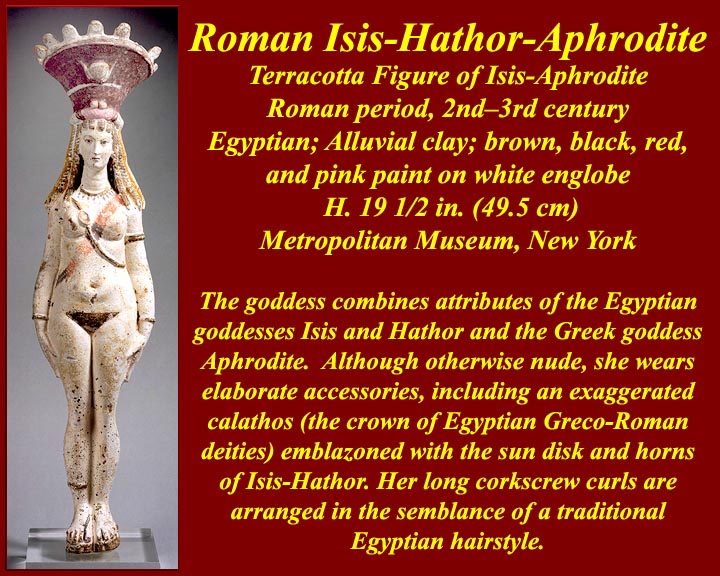
http://www.mmdtkw.org/EGtkw0988IsisHathorAphrodite.jpg
Finally, there is one more syncretism. The image shows a 2end century AD Egyptian terracotta figurine of Isis-Hath or-Aphrodite from the collection of the Metropolitan Museum in New York. Its exact provenance is unknown. She is certainly Isis-Hath or: the front of her crown is decorated with her horns and solar disk. But he's also the Greek Aphrodite with here exaggerated calathos headgear. Identification of Isis-Hathor with Aphrodite-Venus was a common belief of second century Egypt.
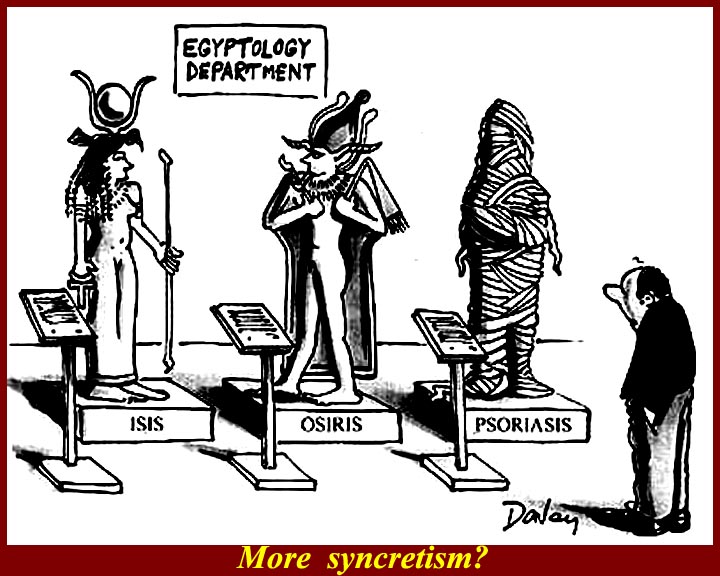
http://www.mmdtkw.org/EGtkw0989MoreSyncretism.jpg
More syncretism.
